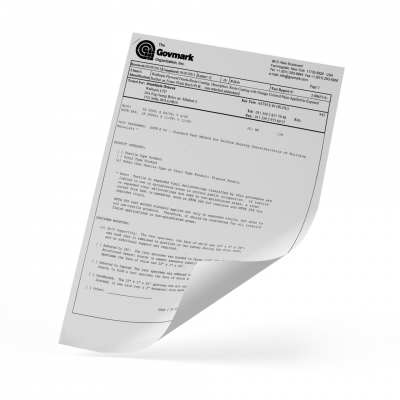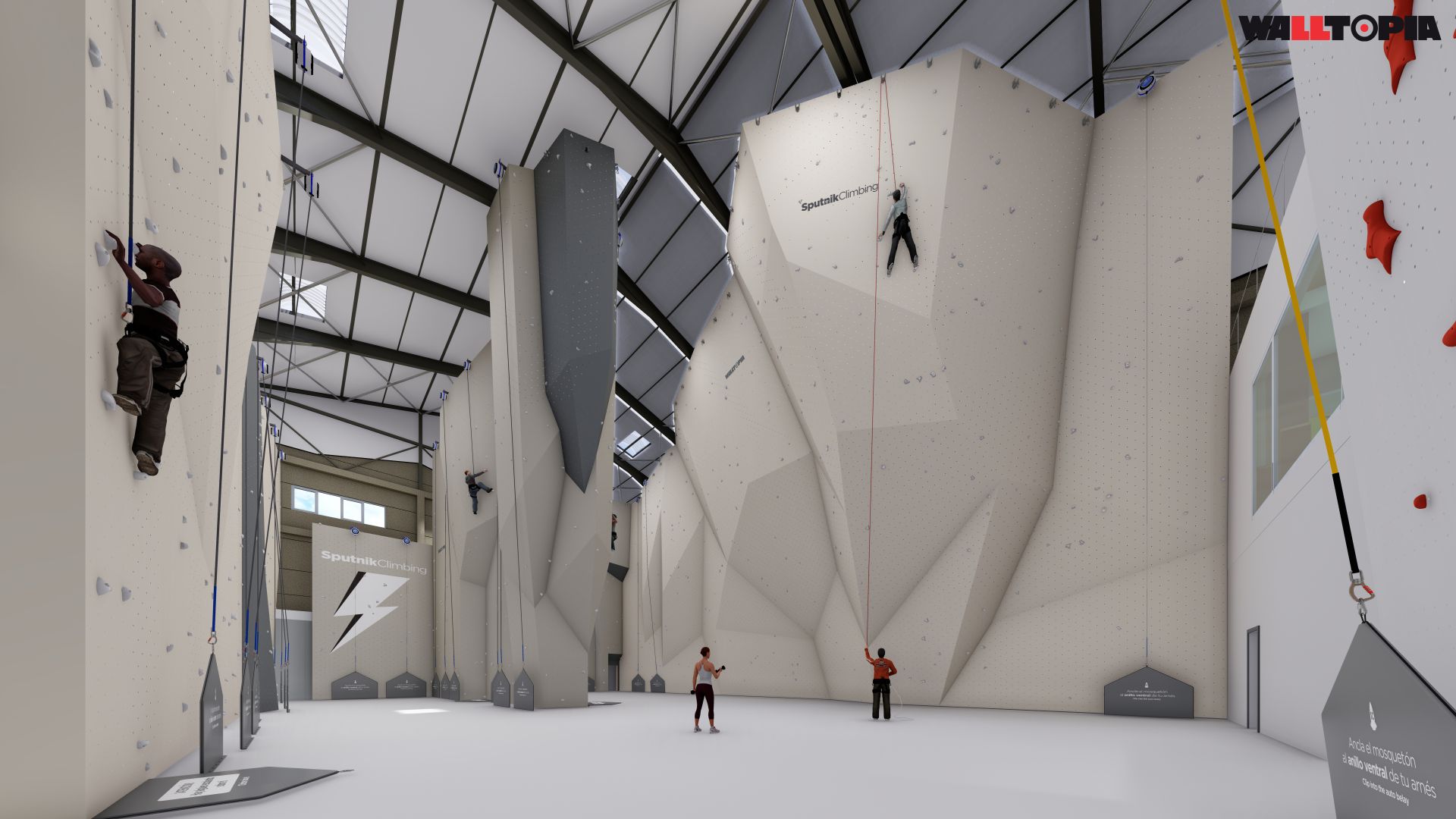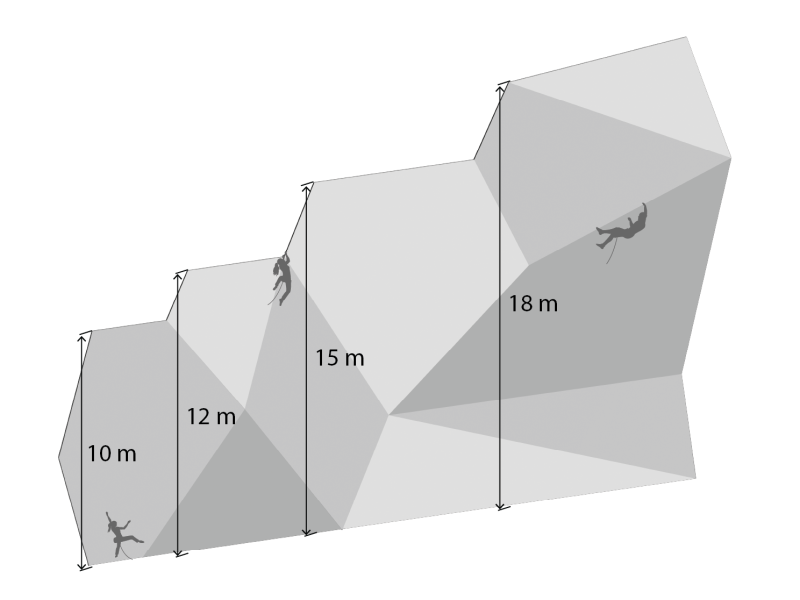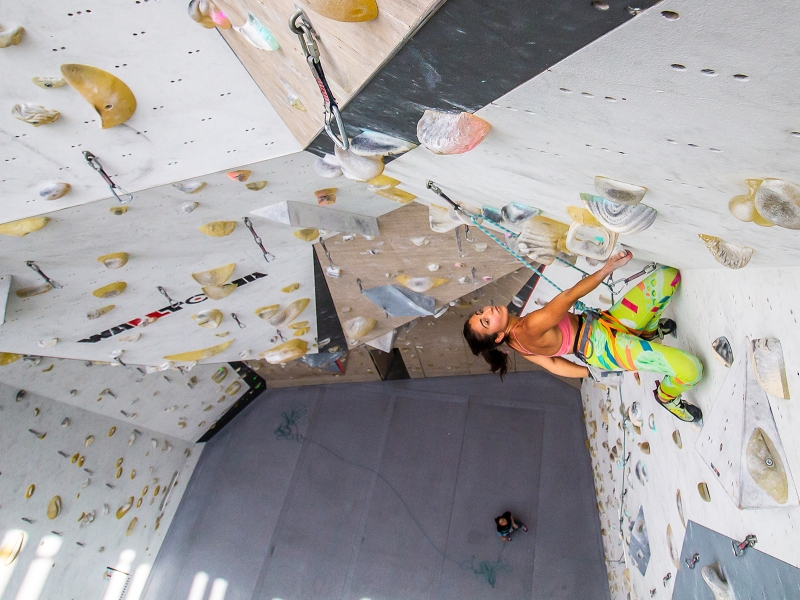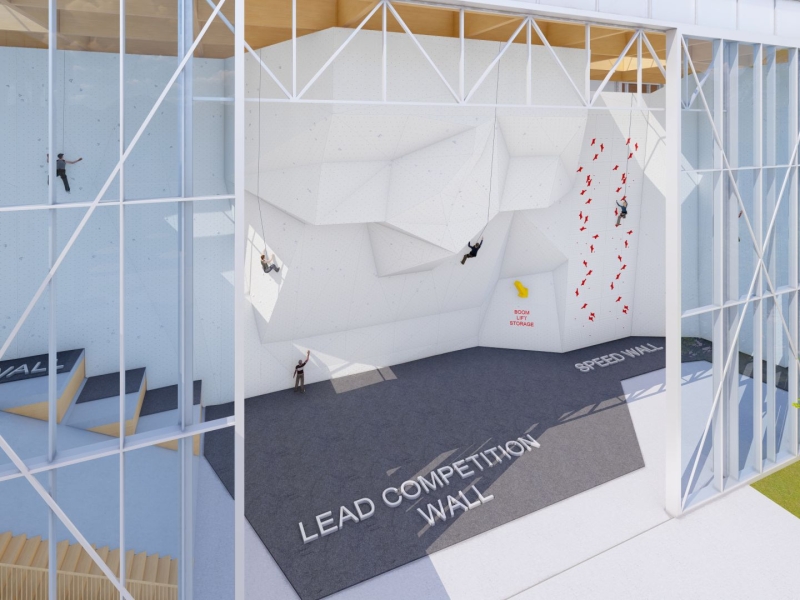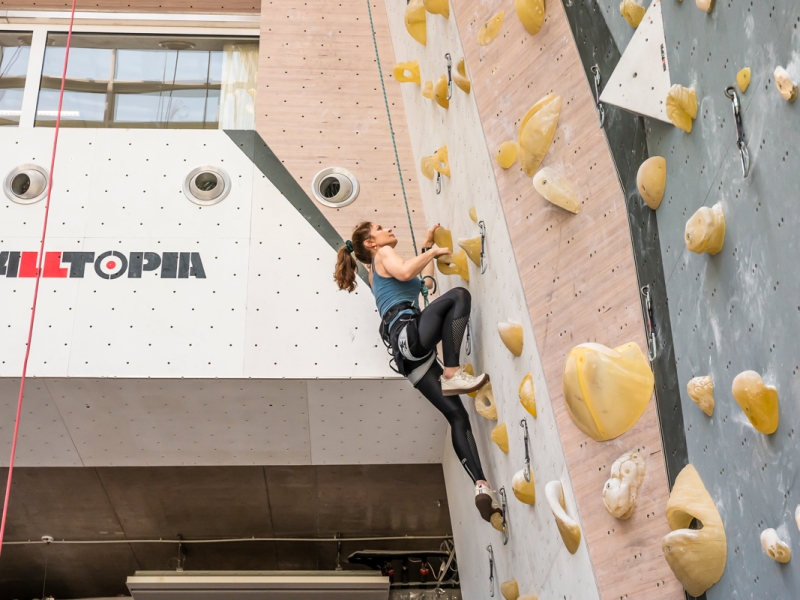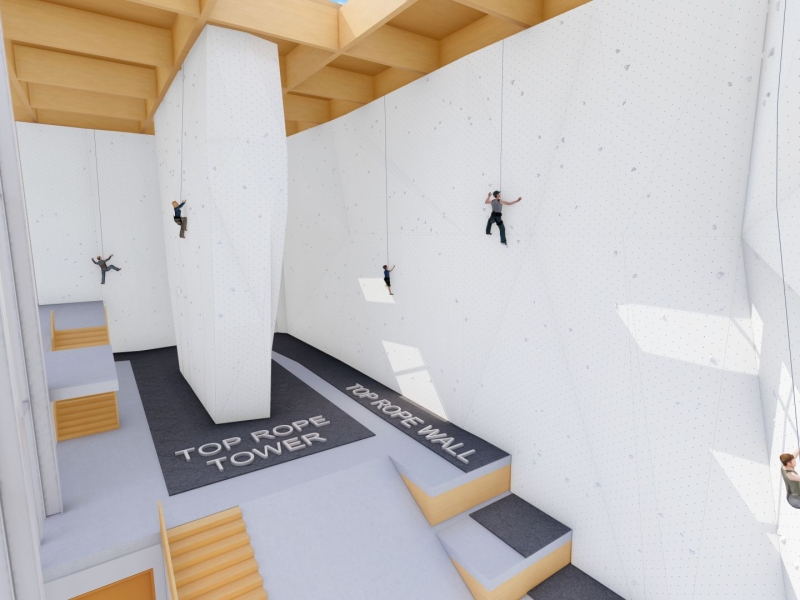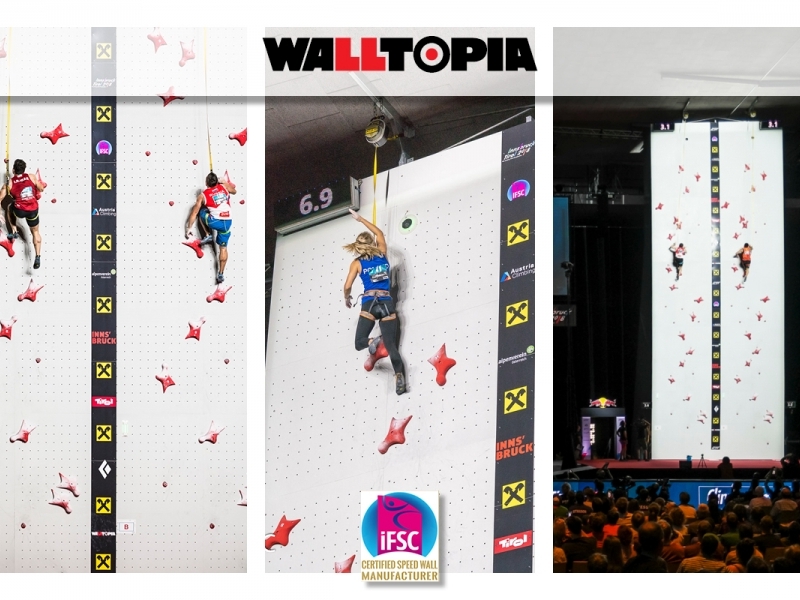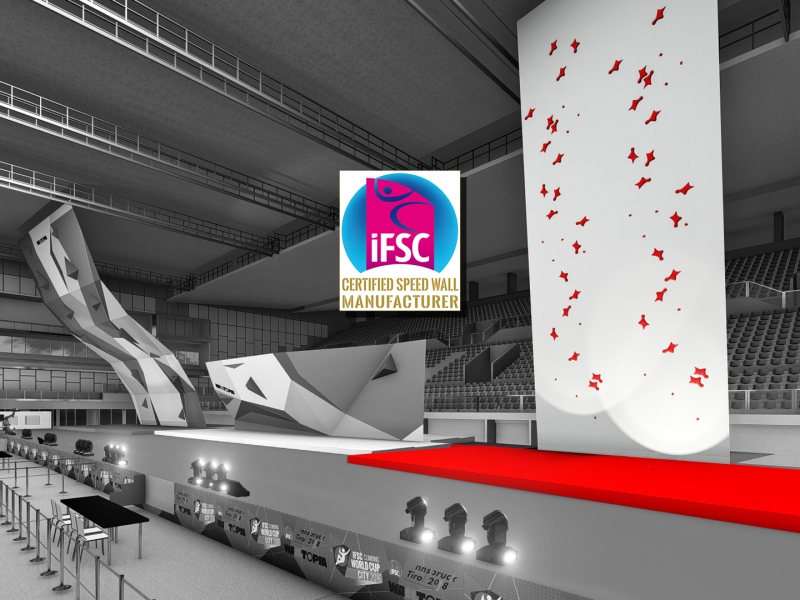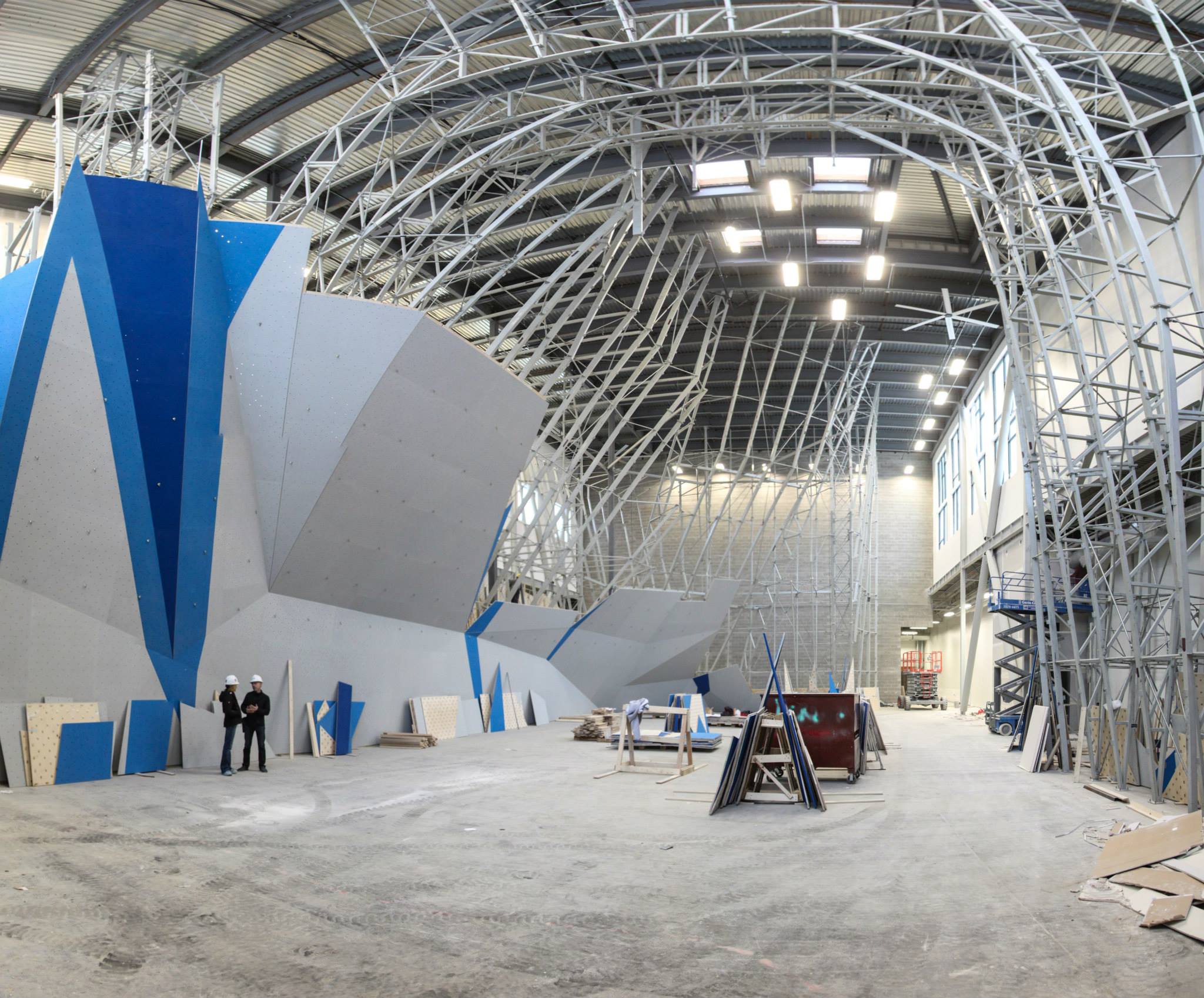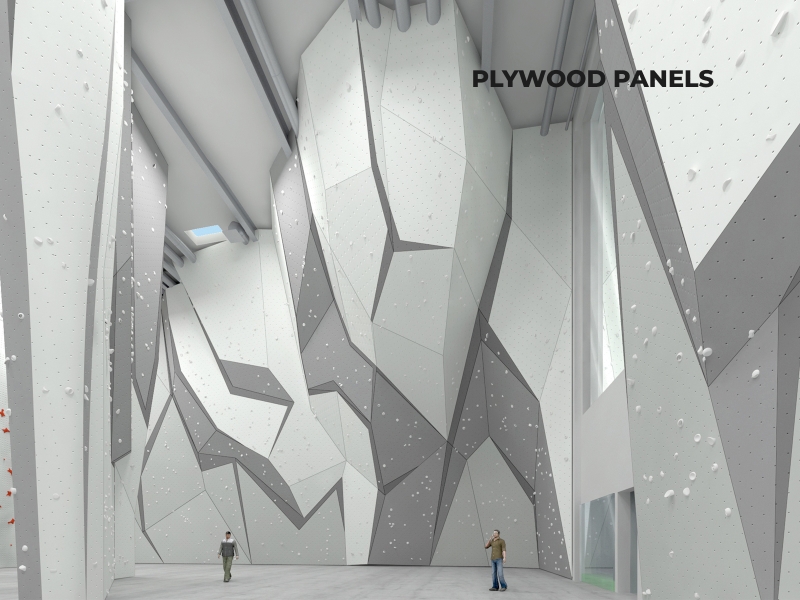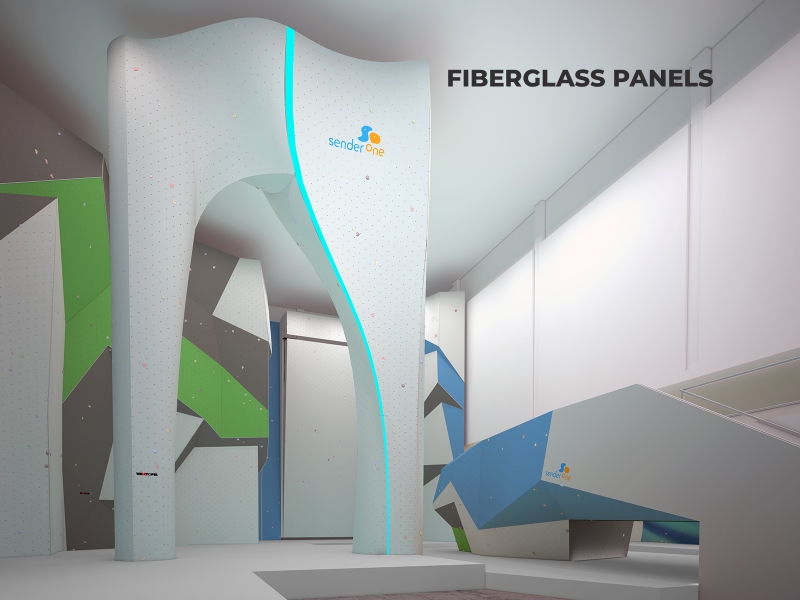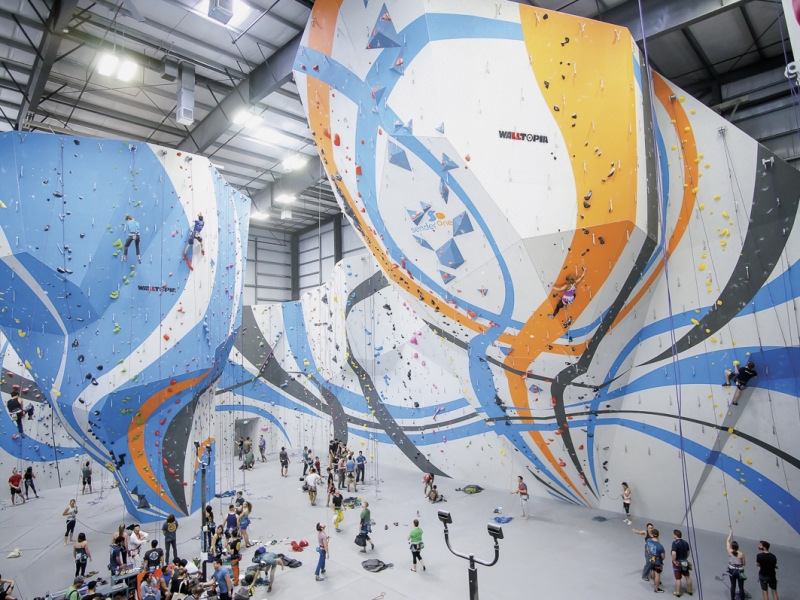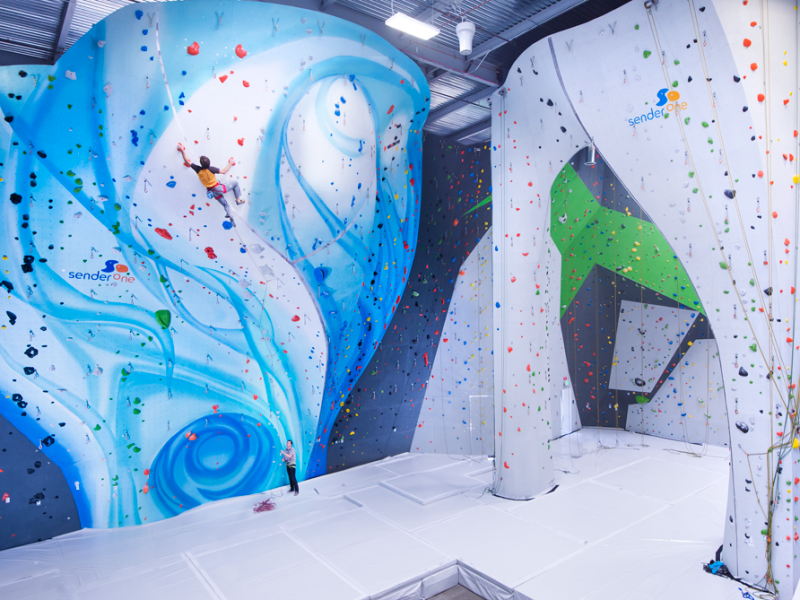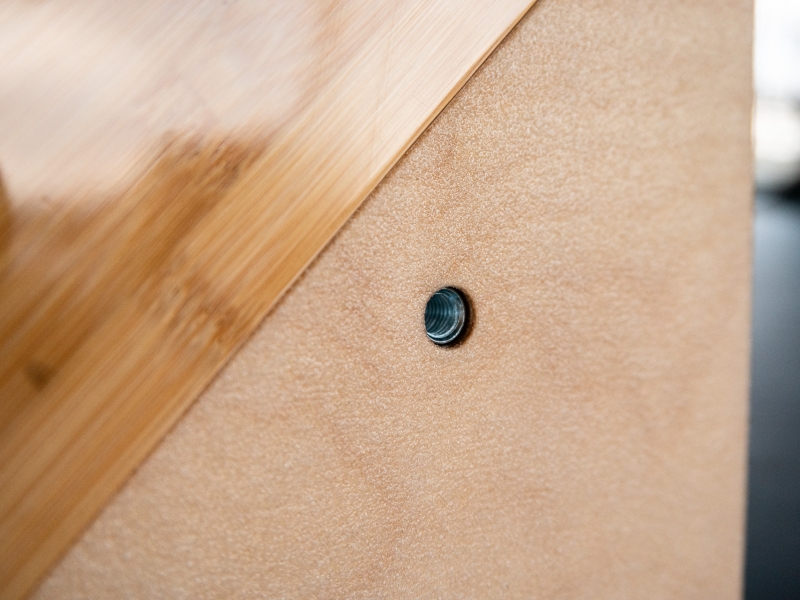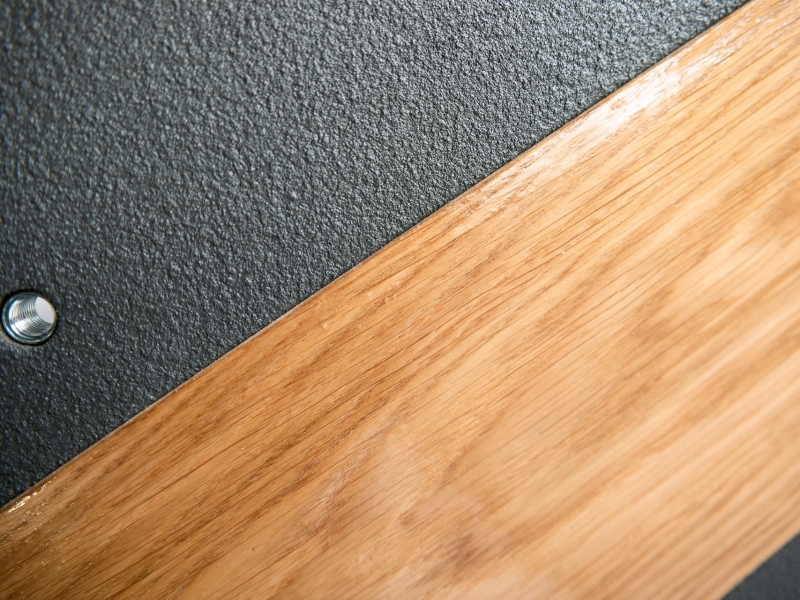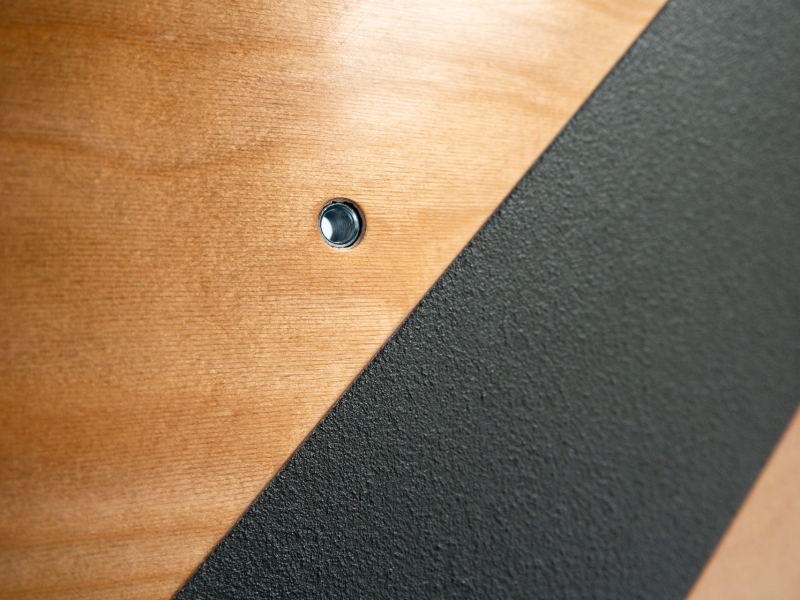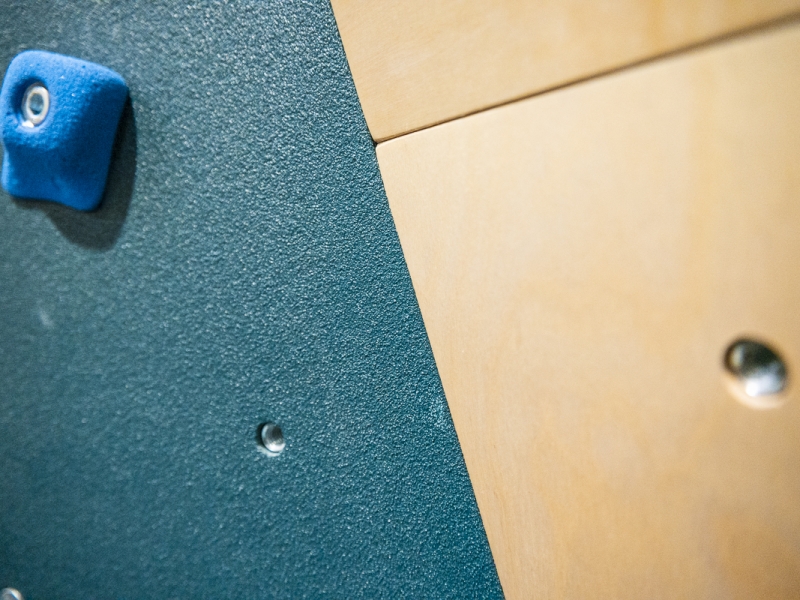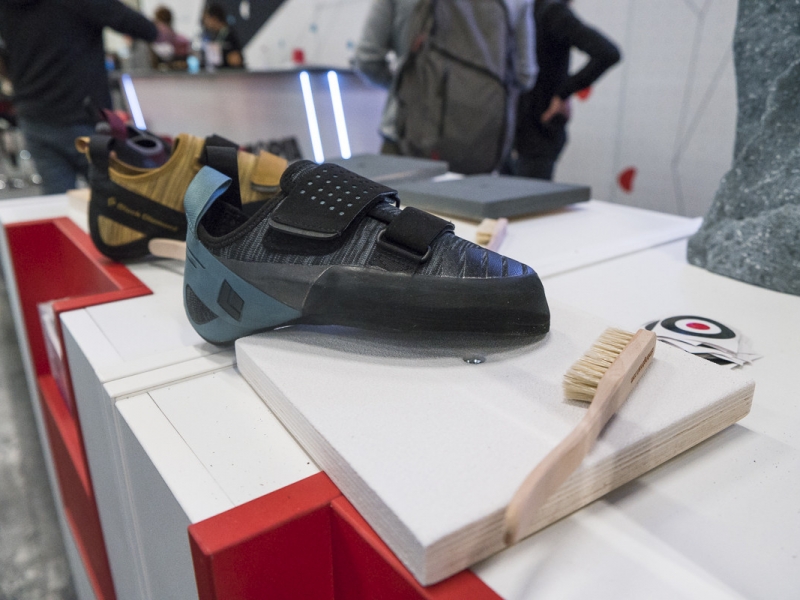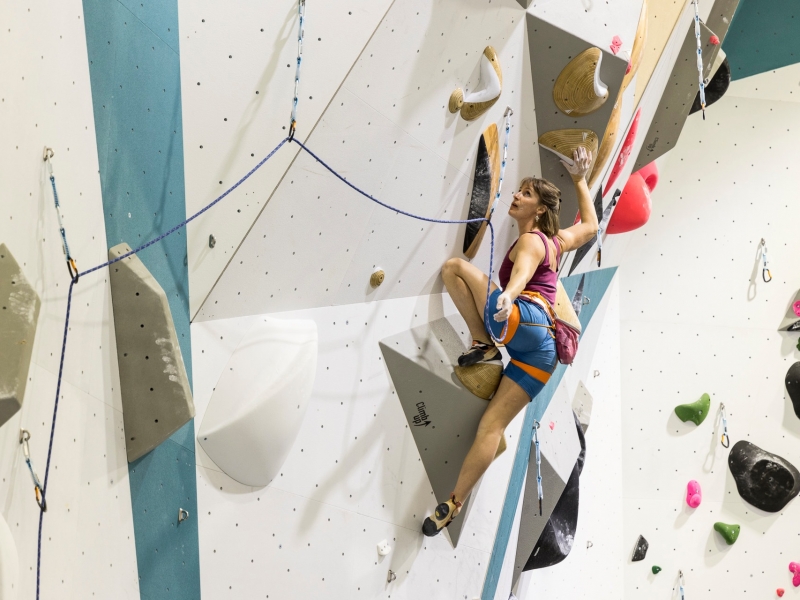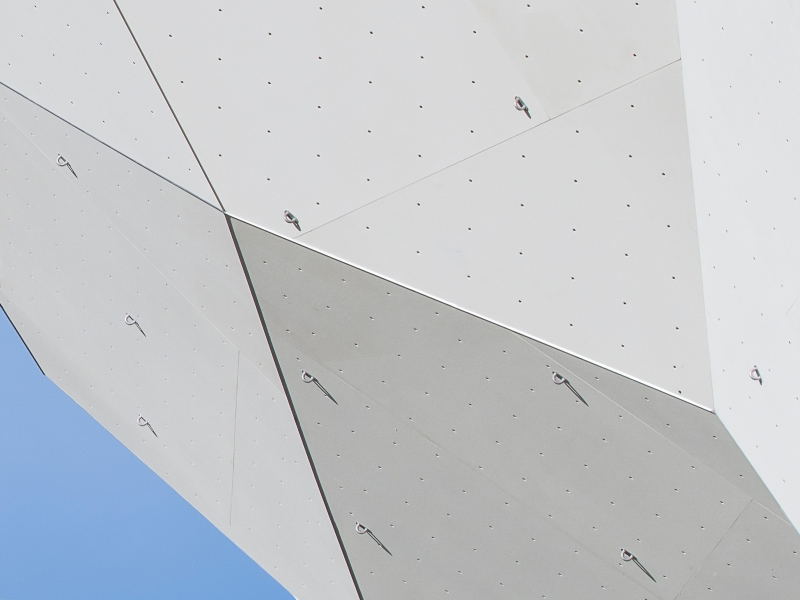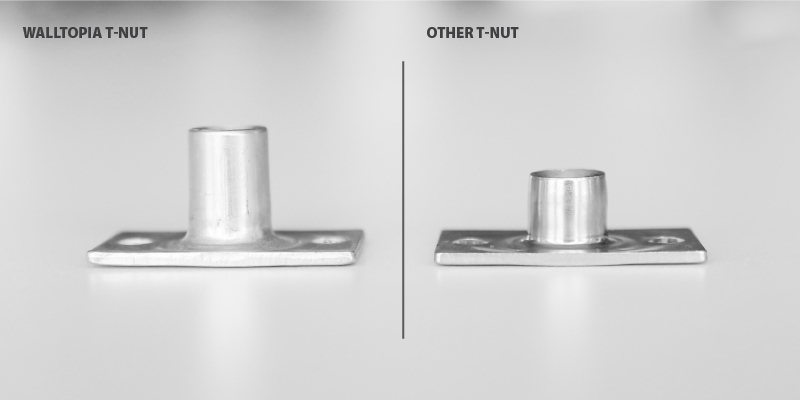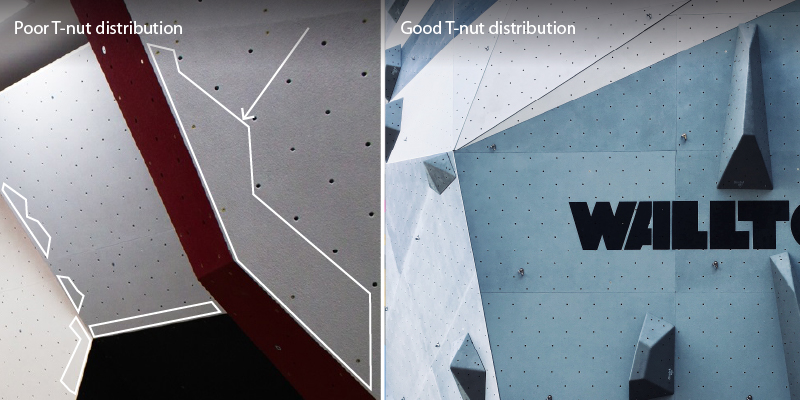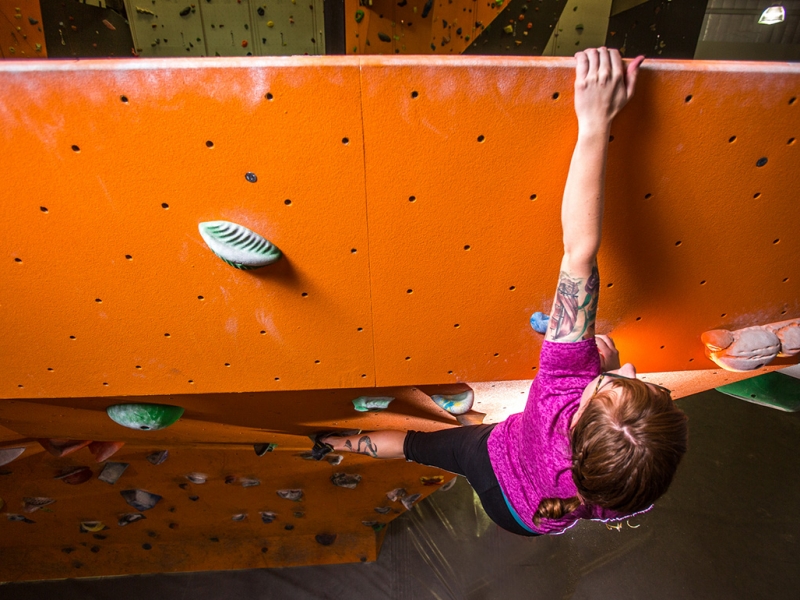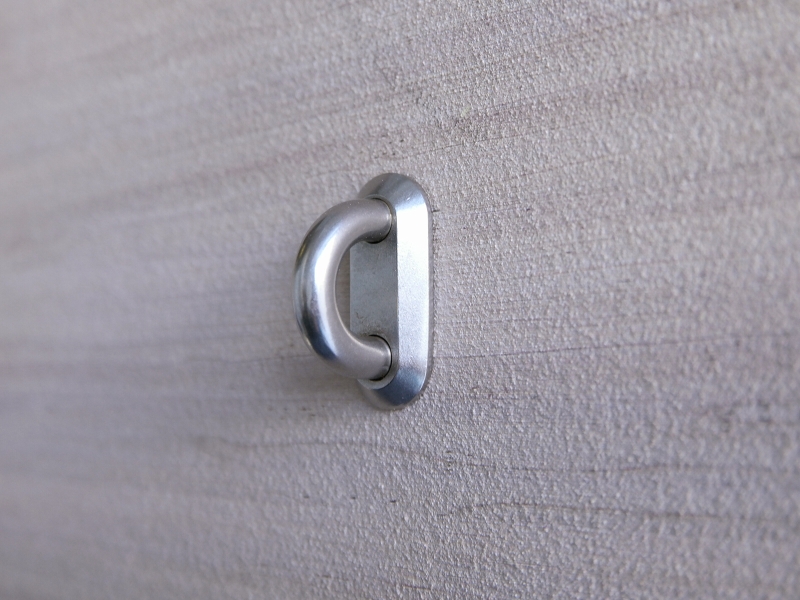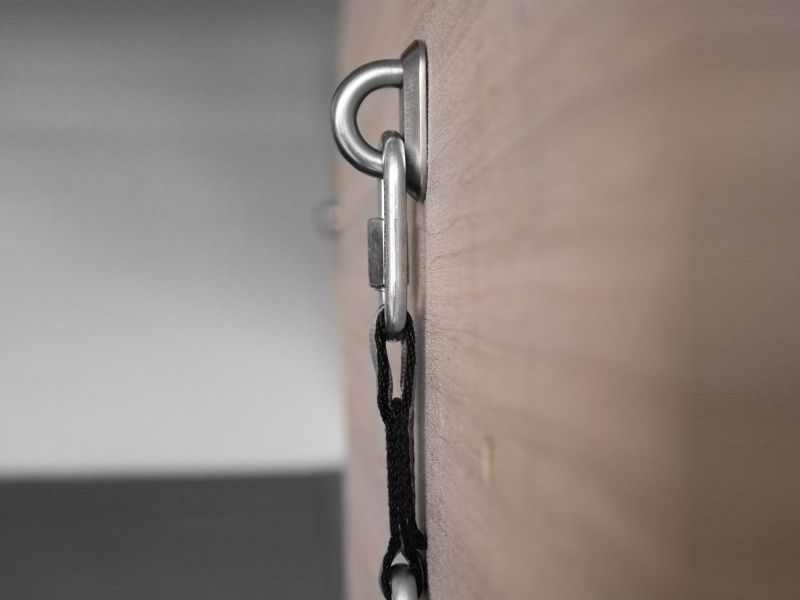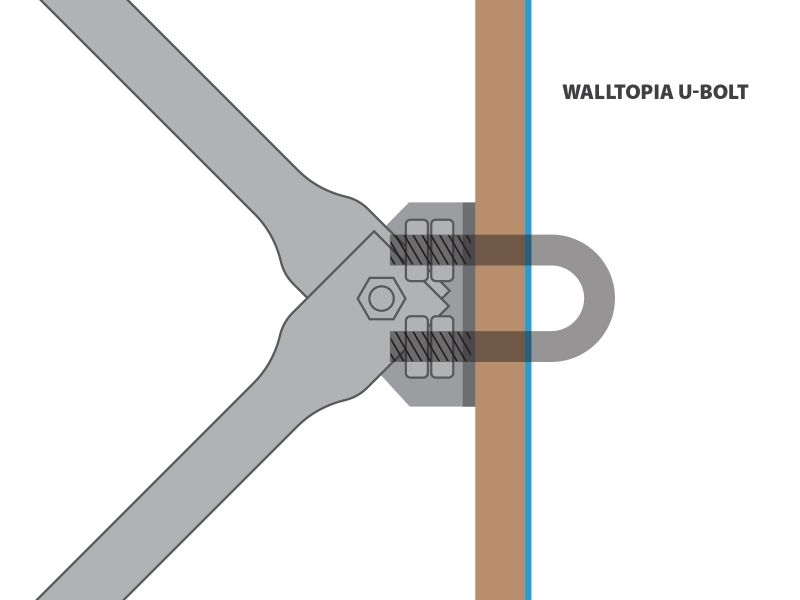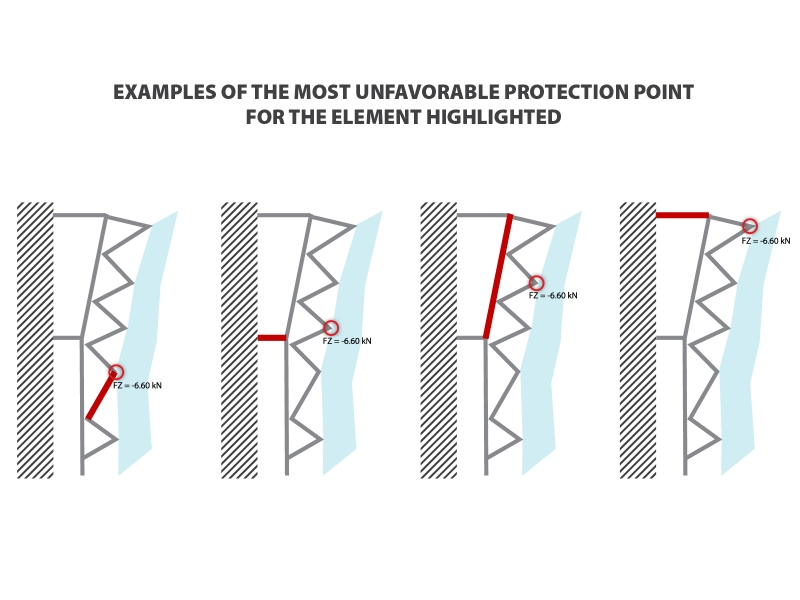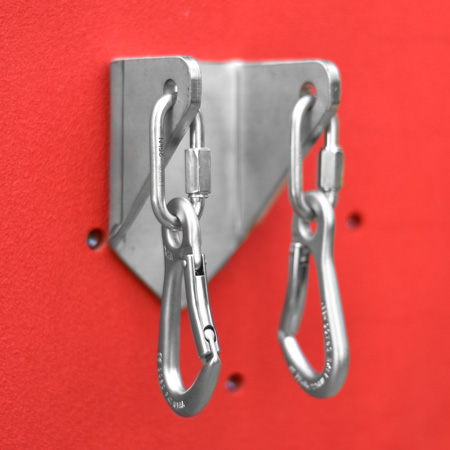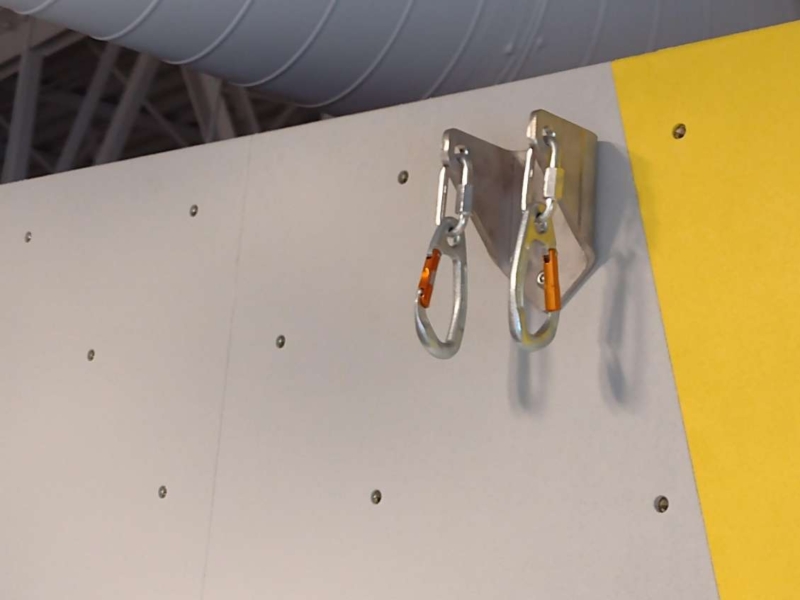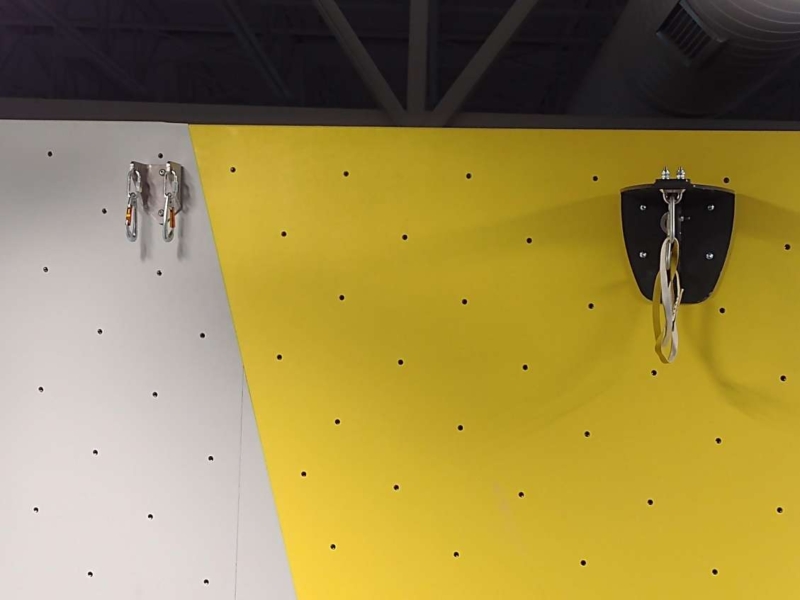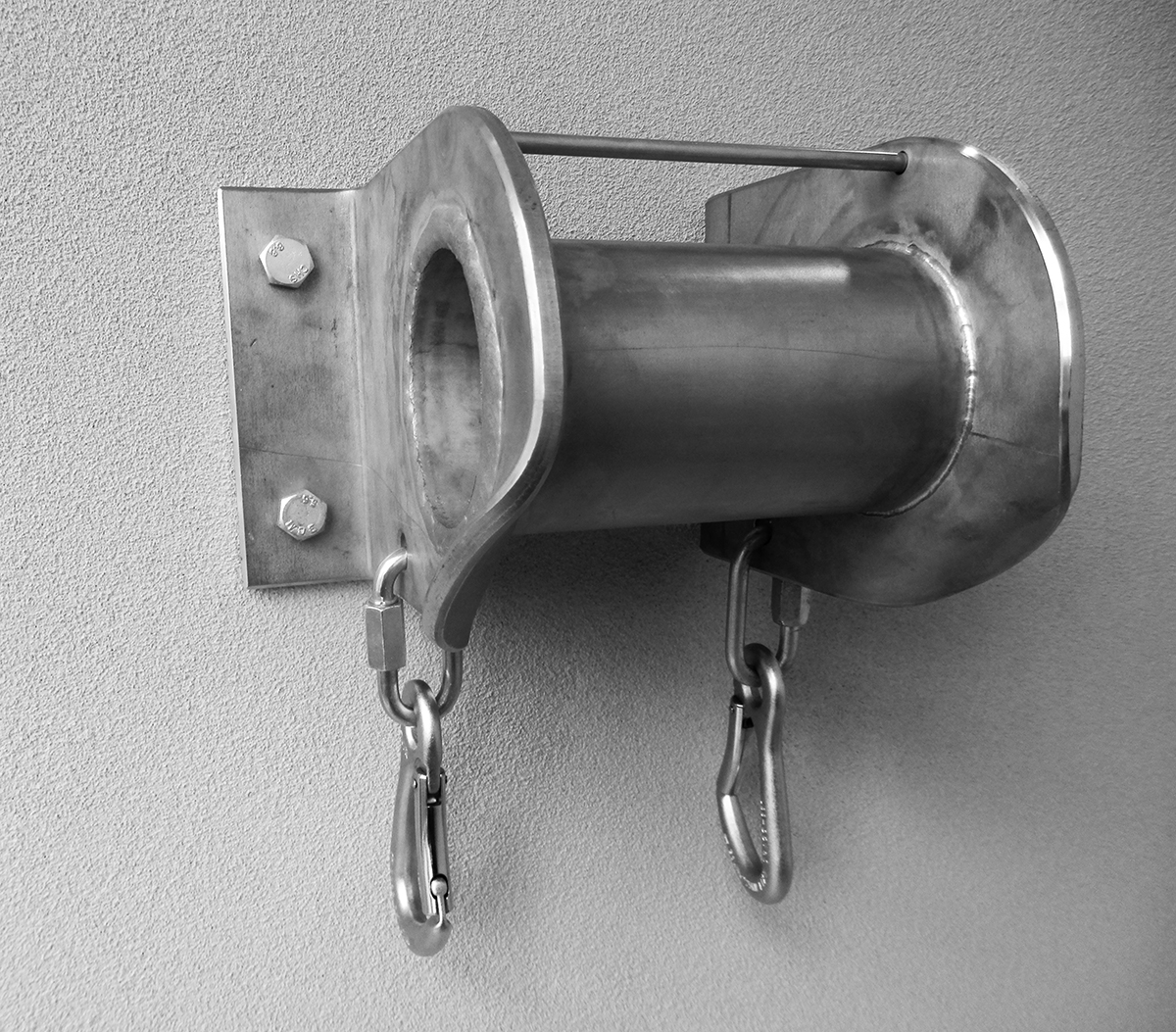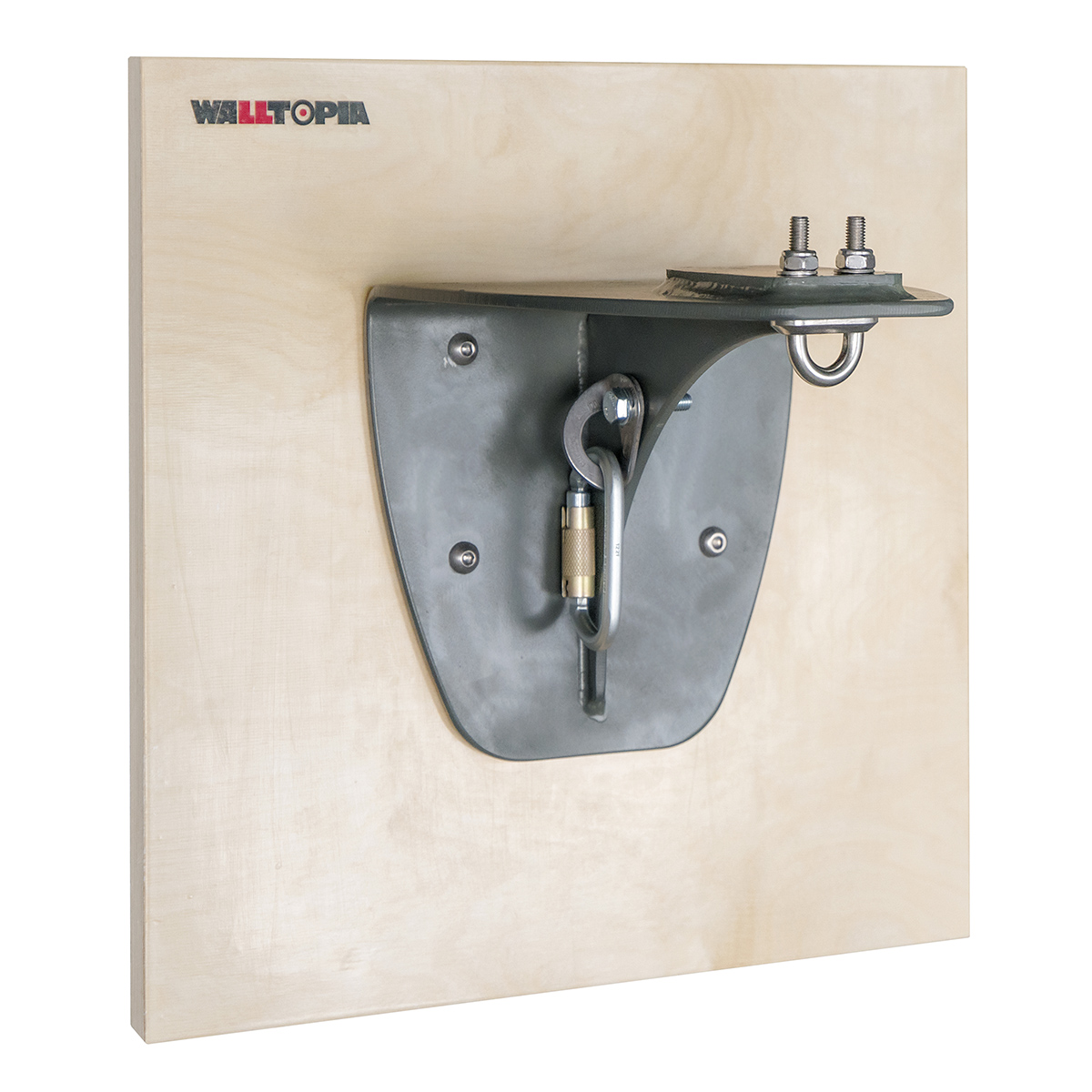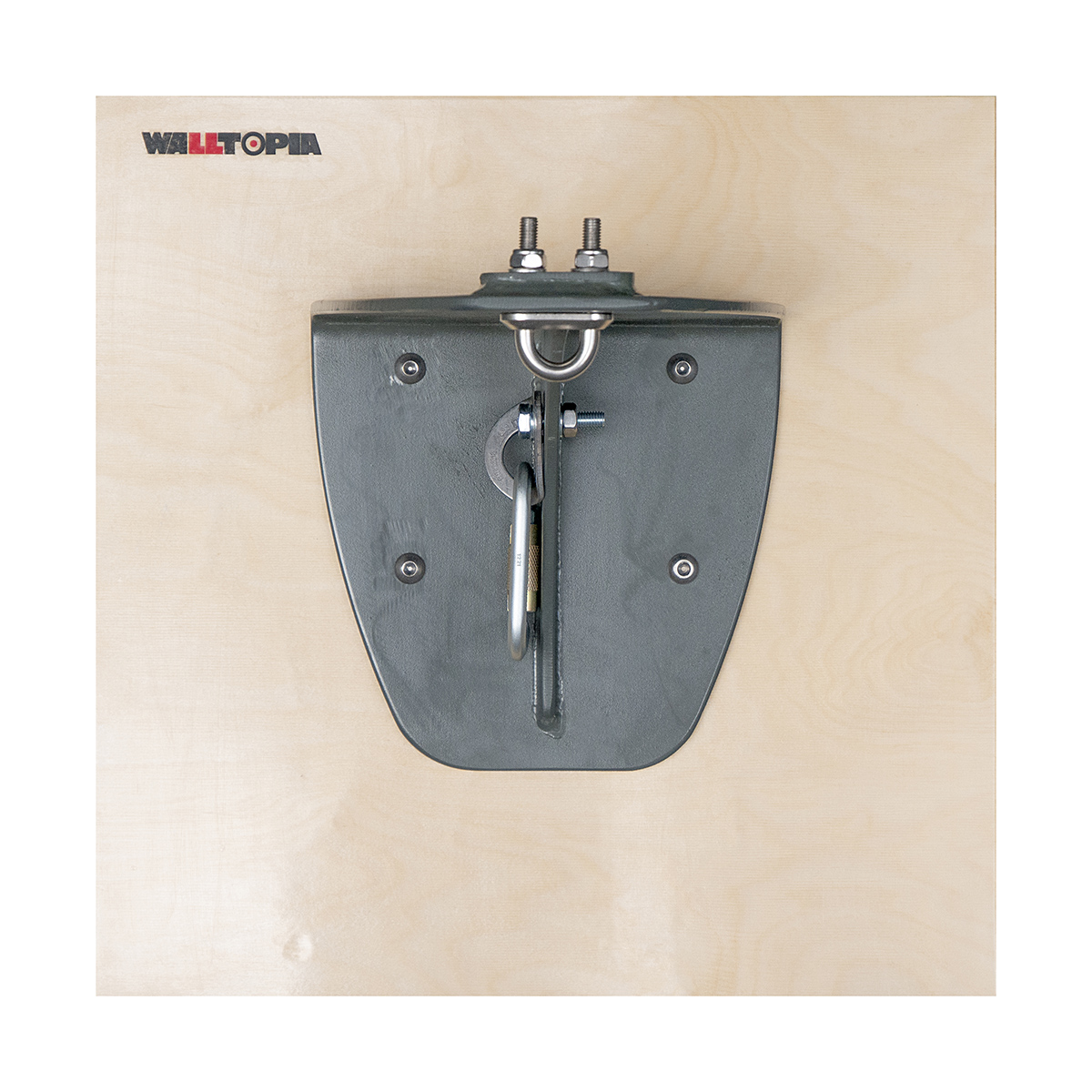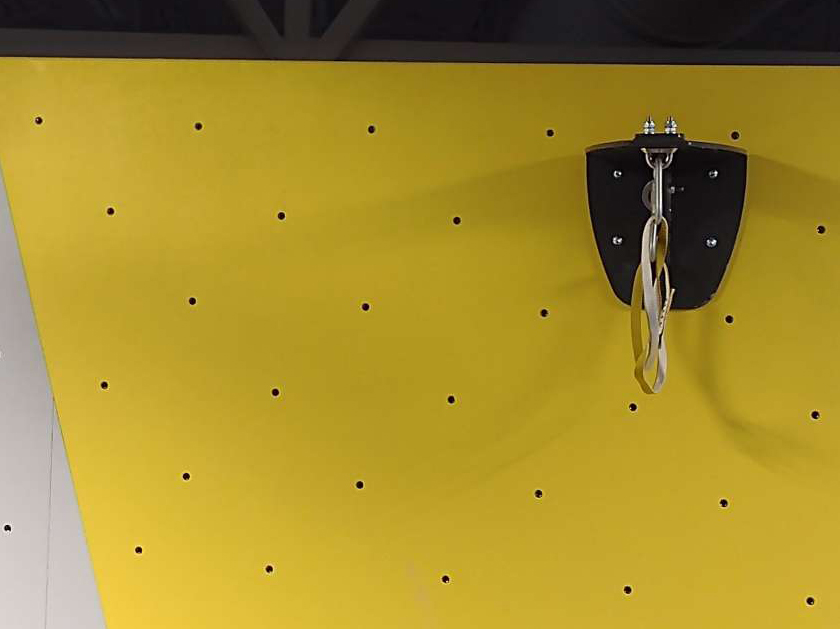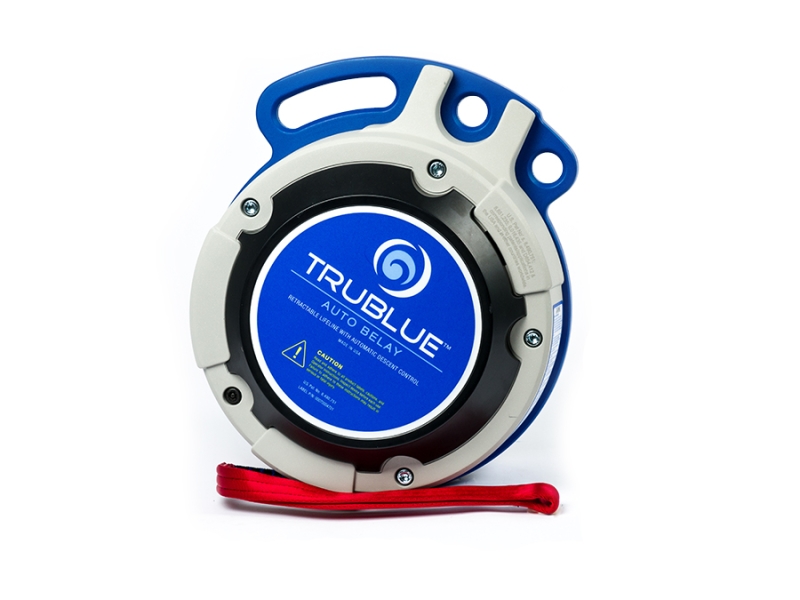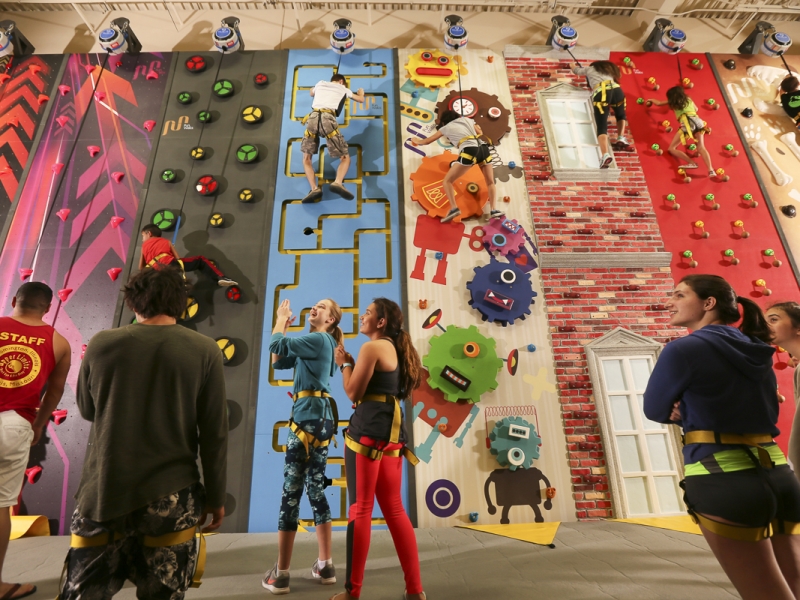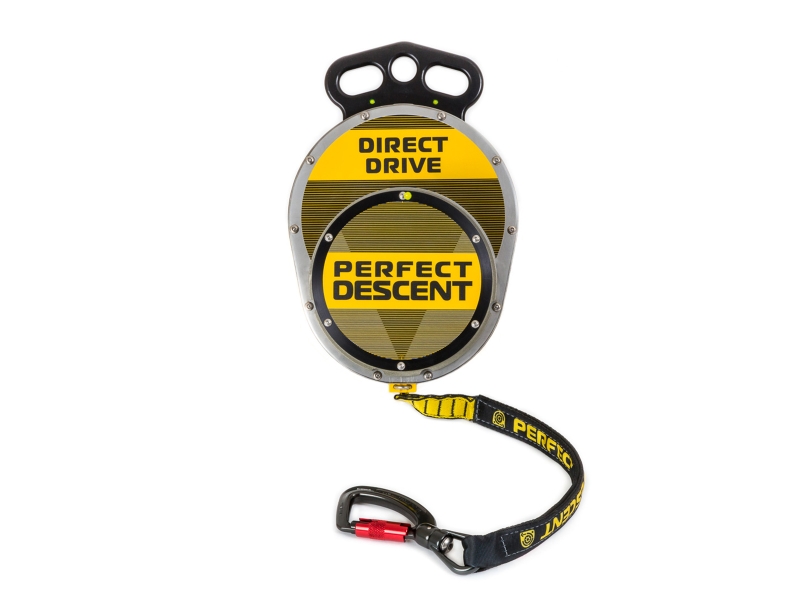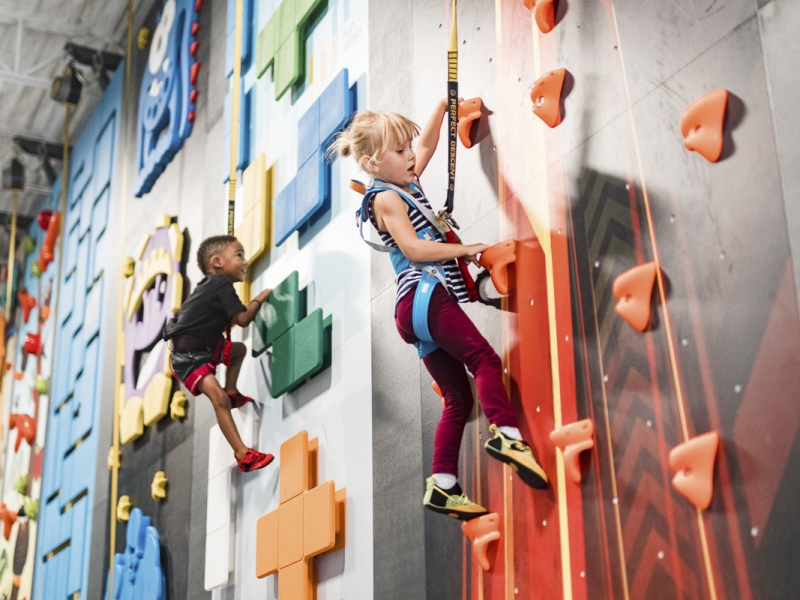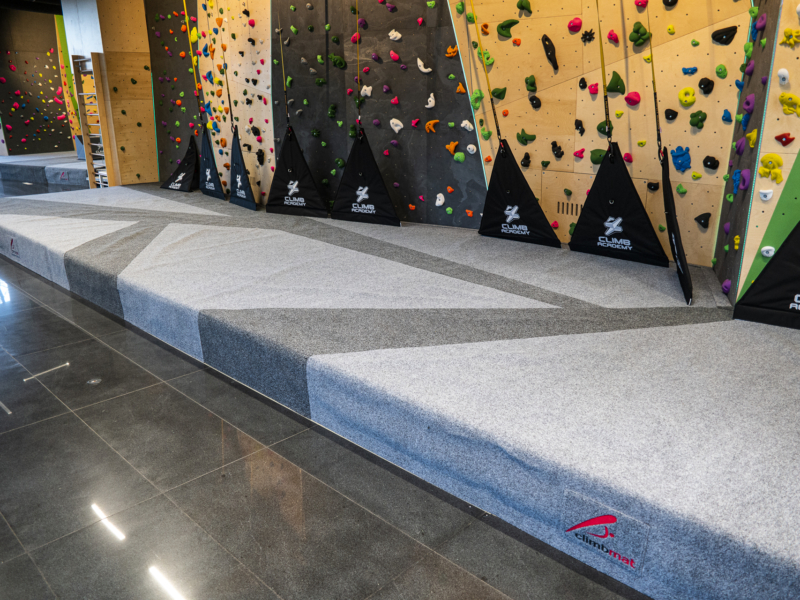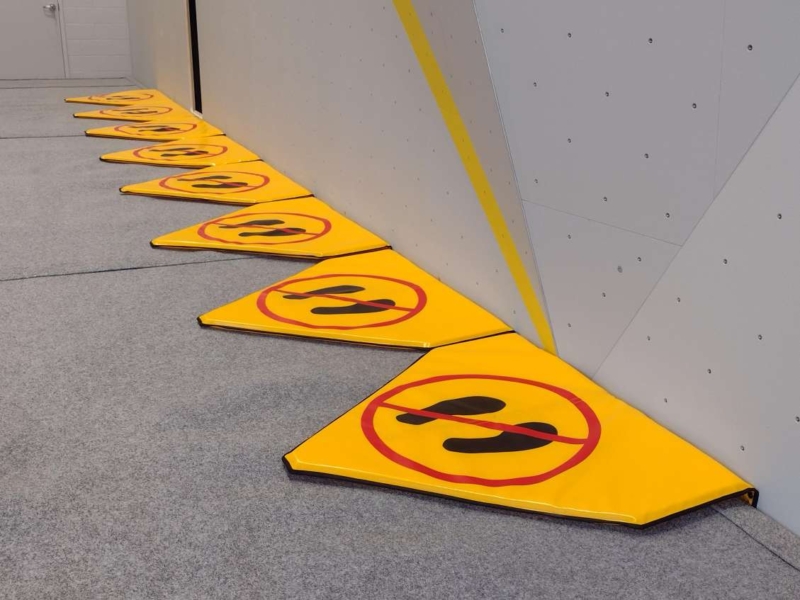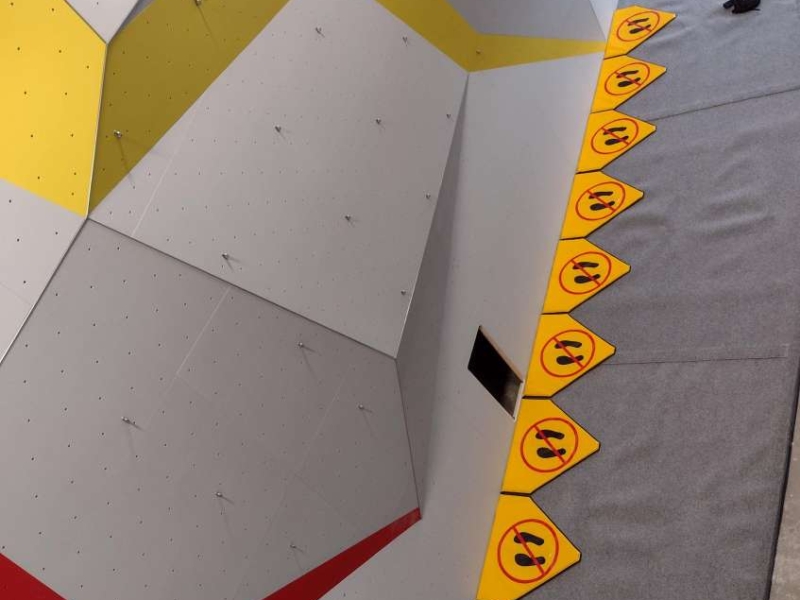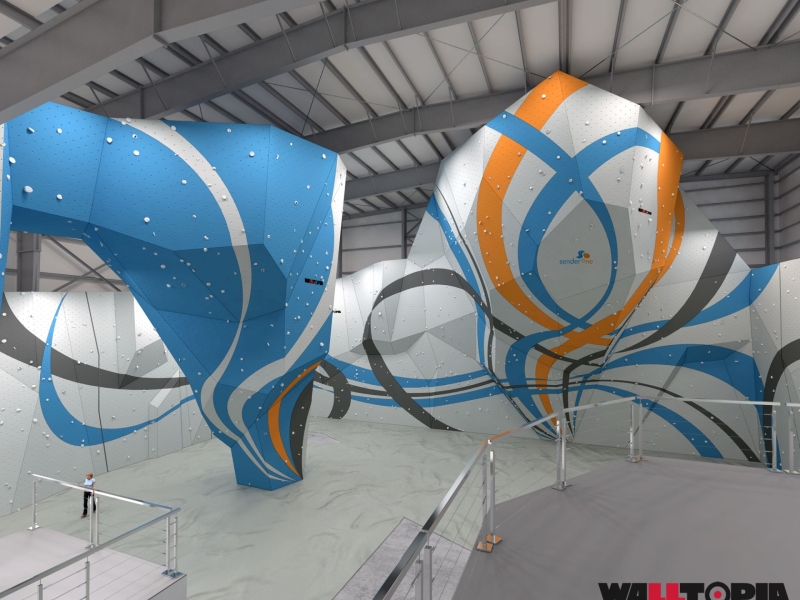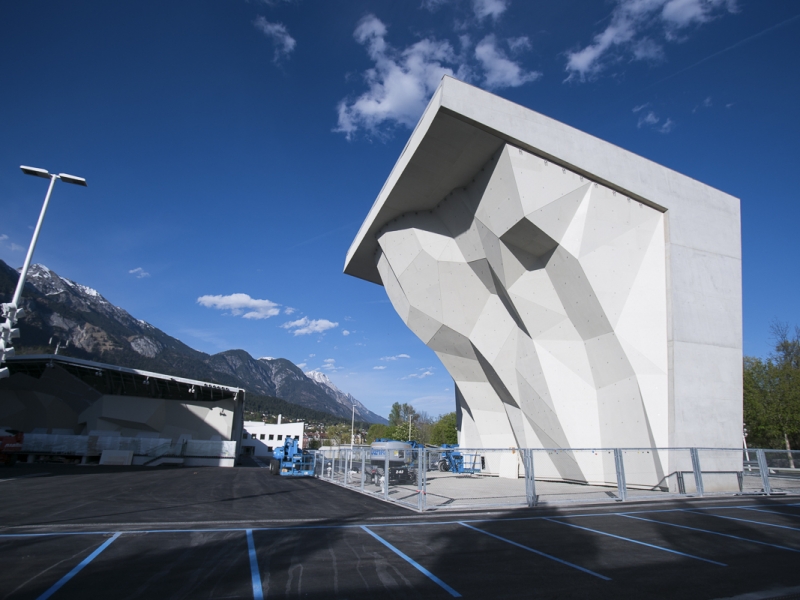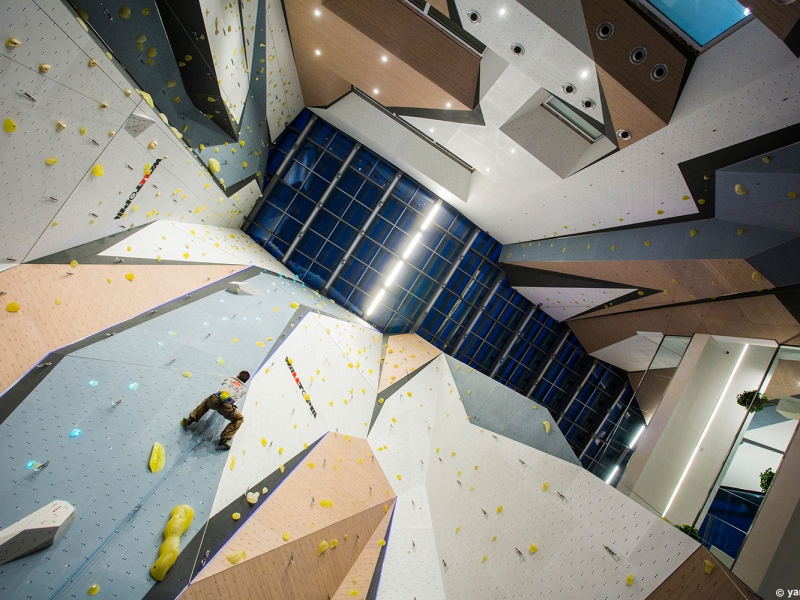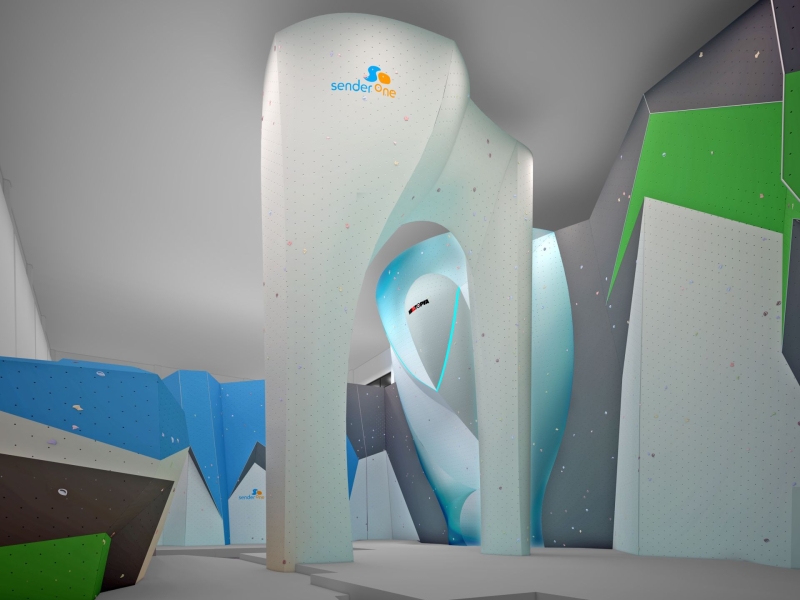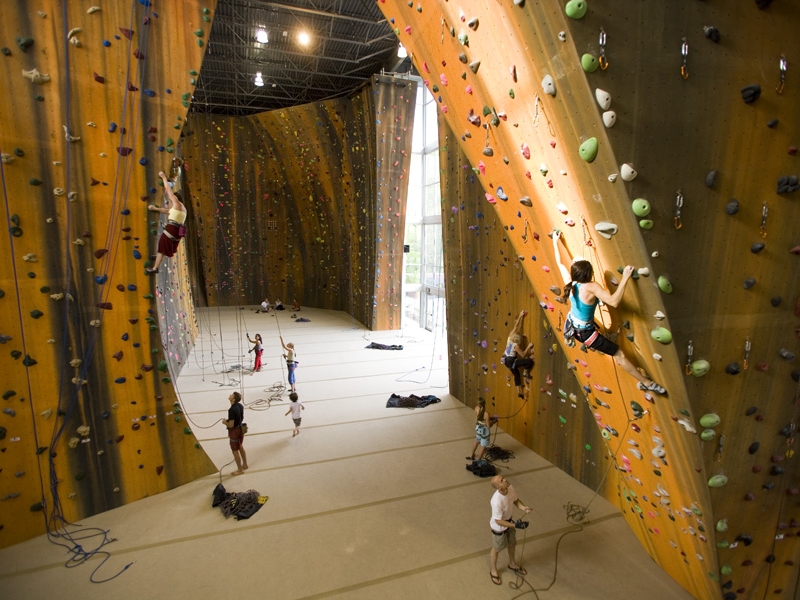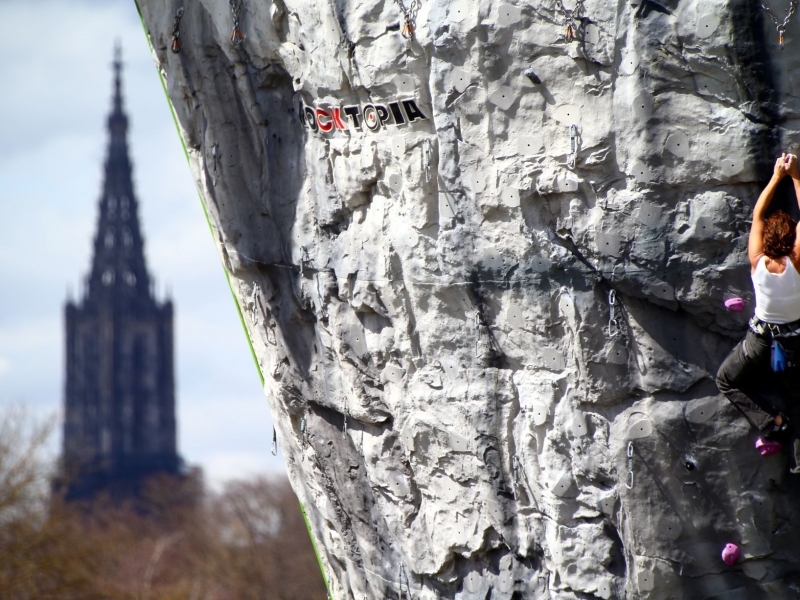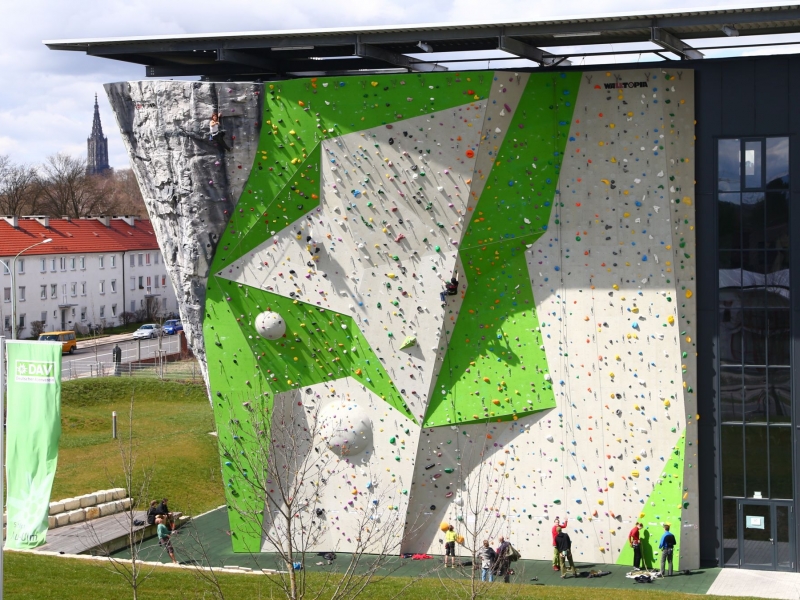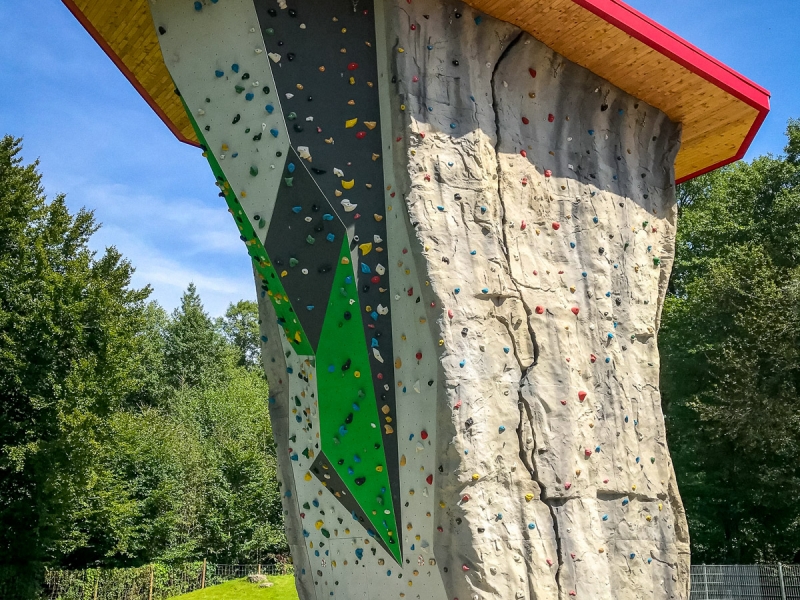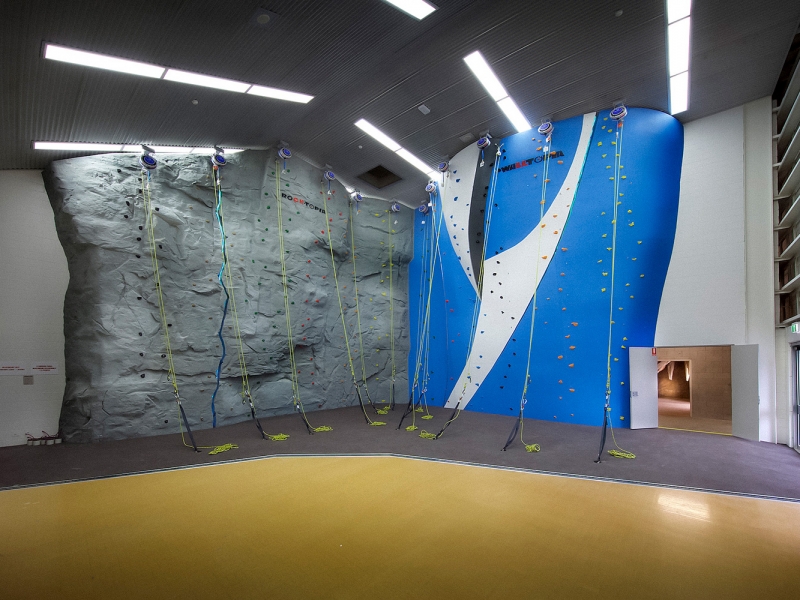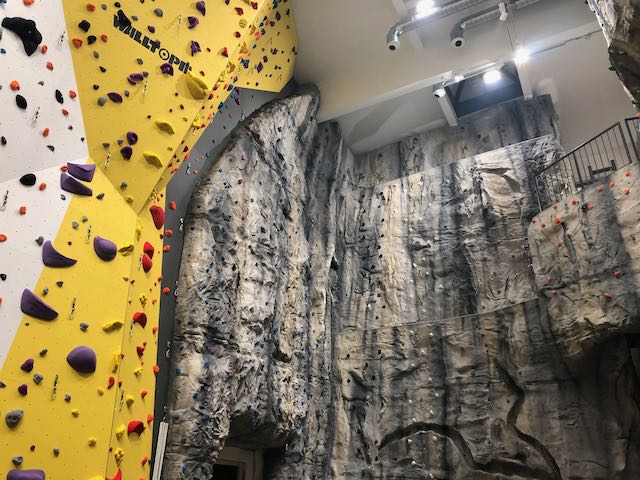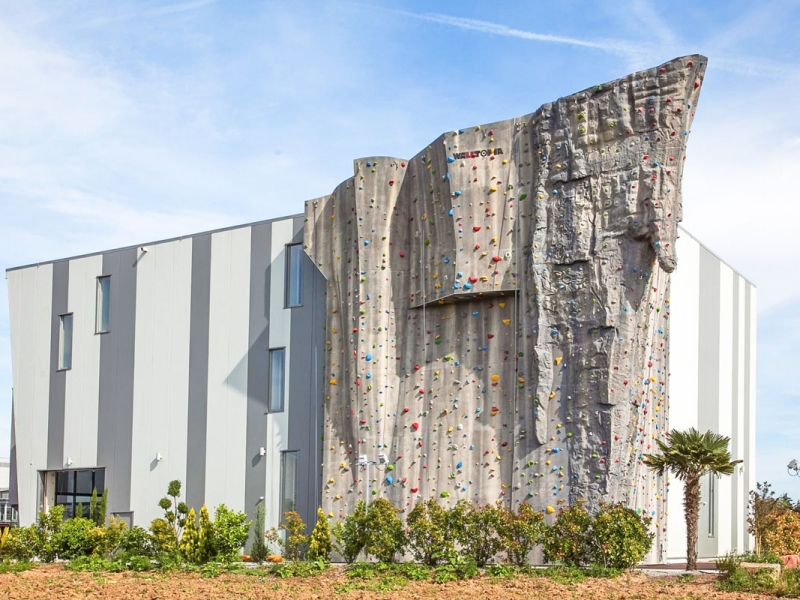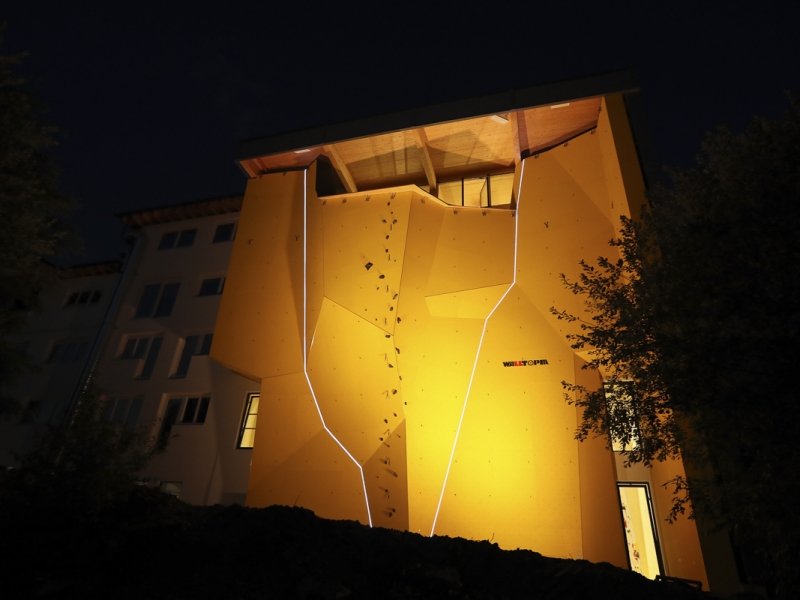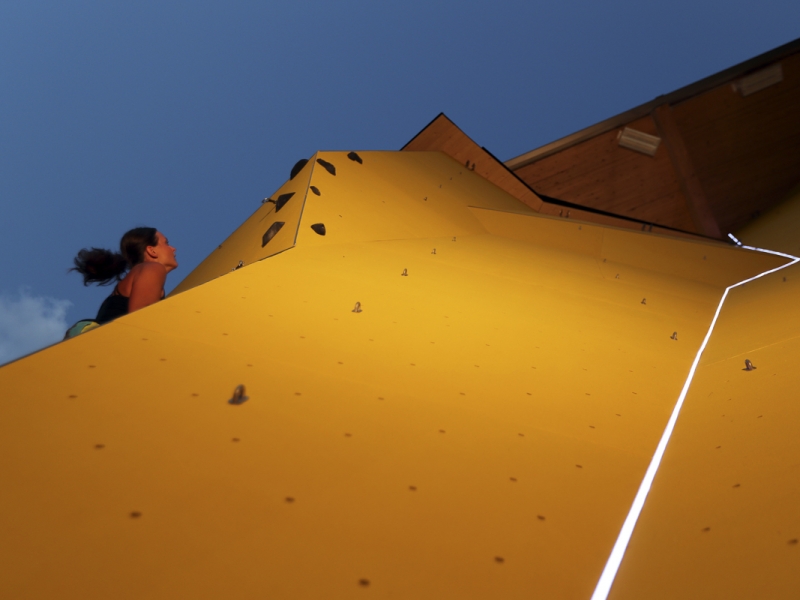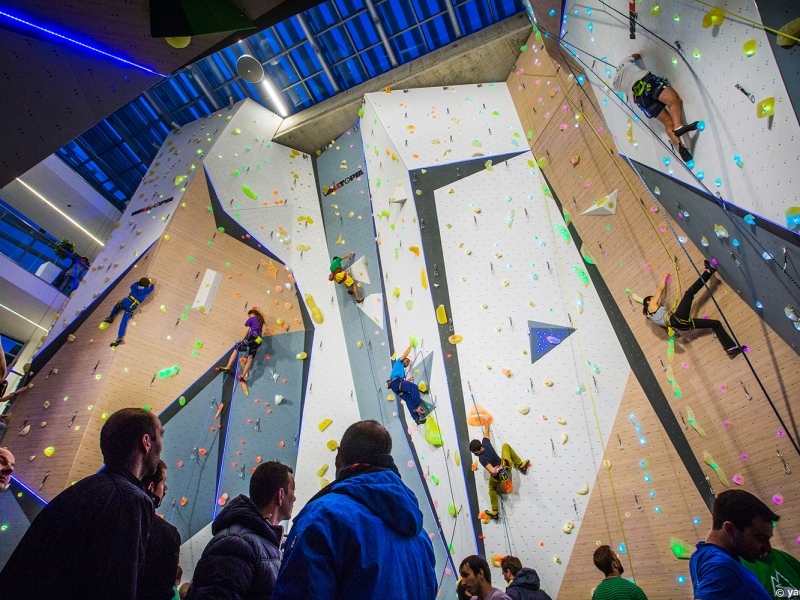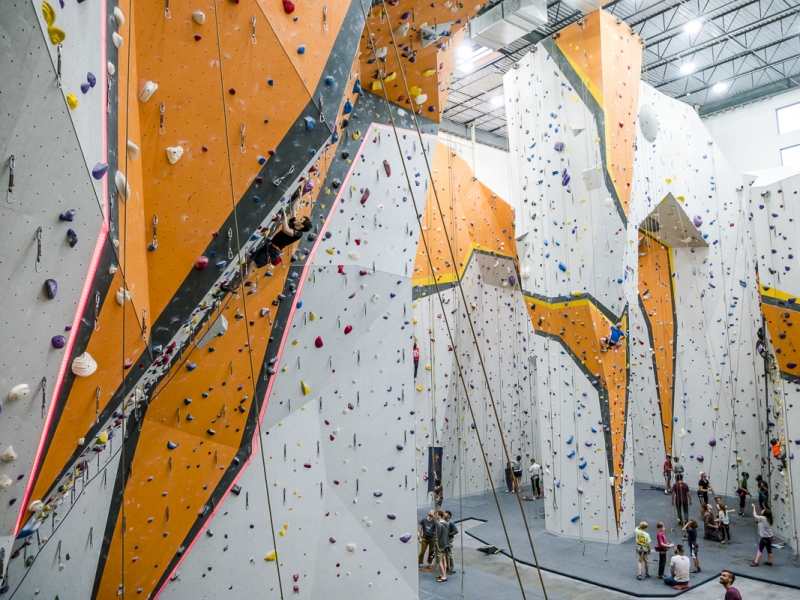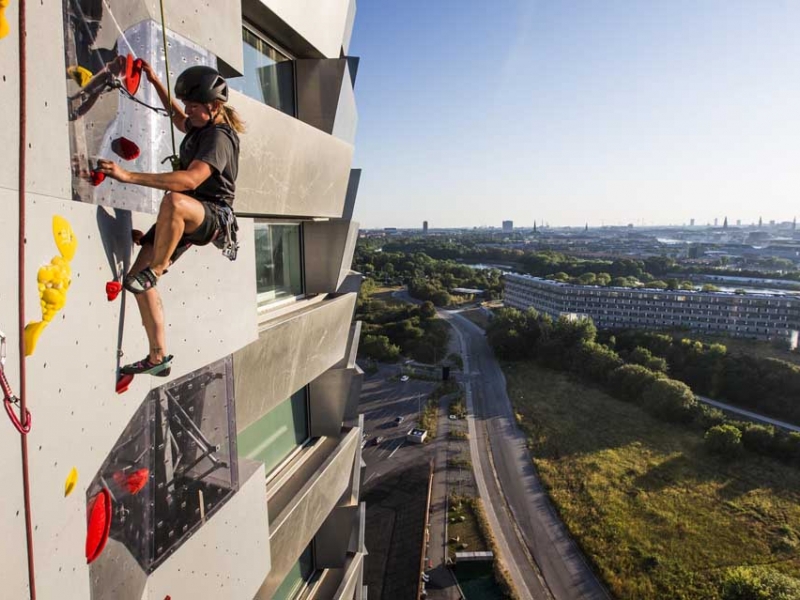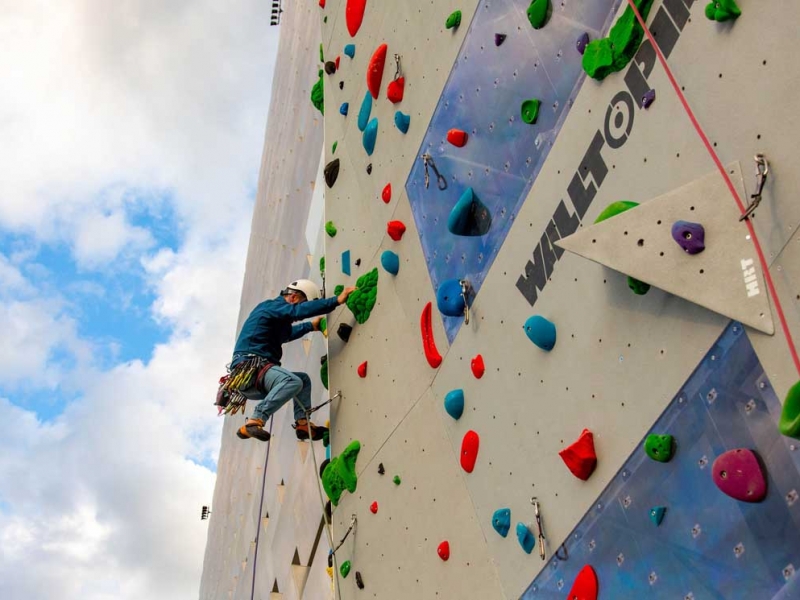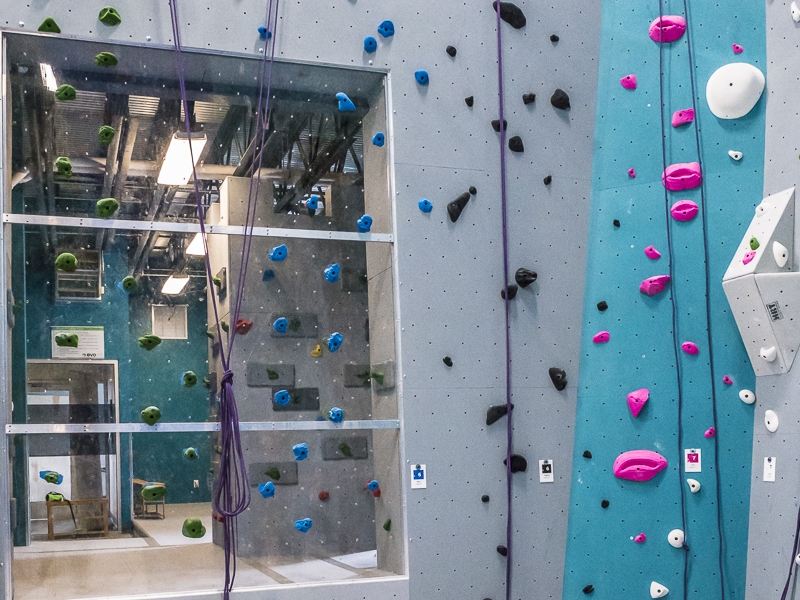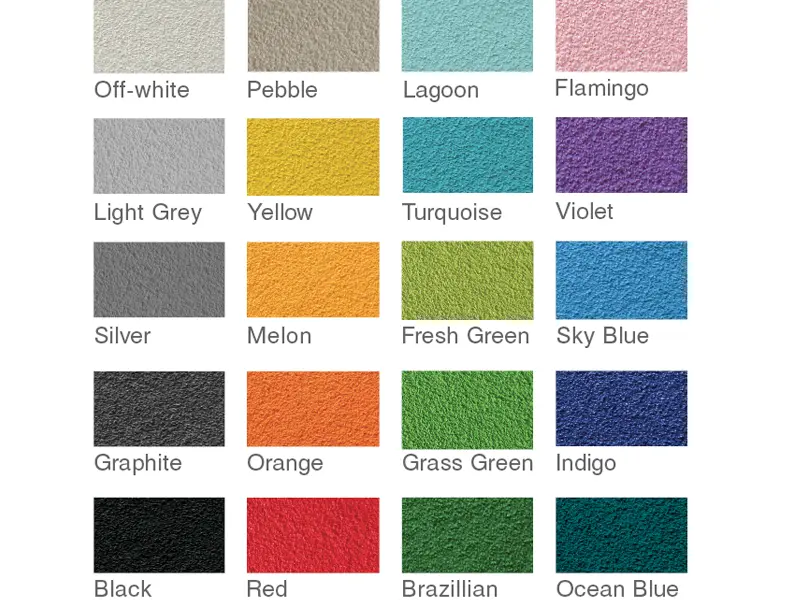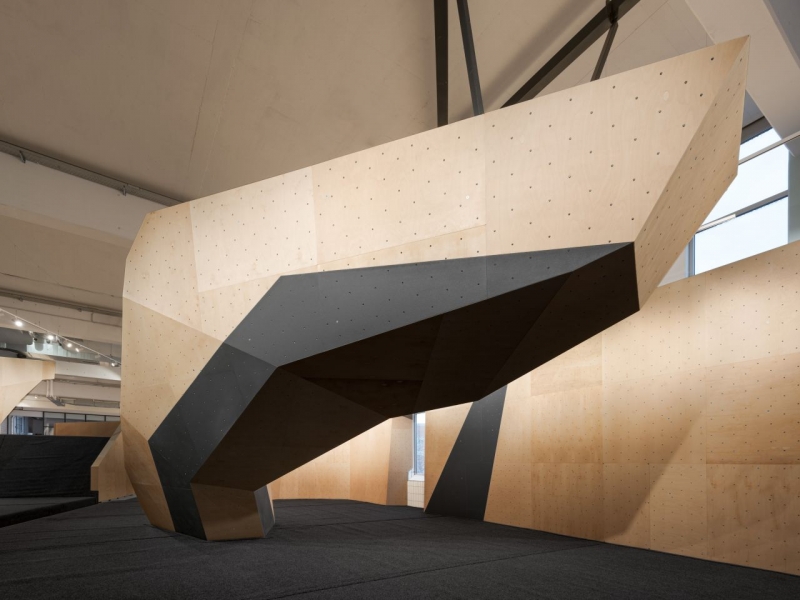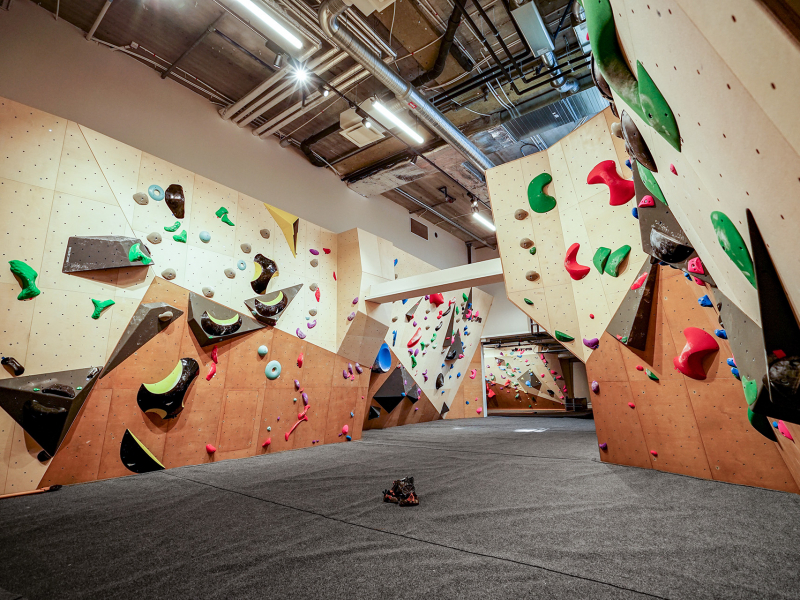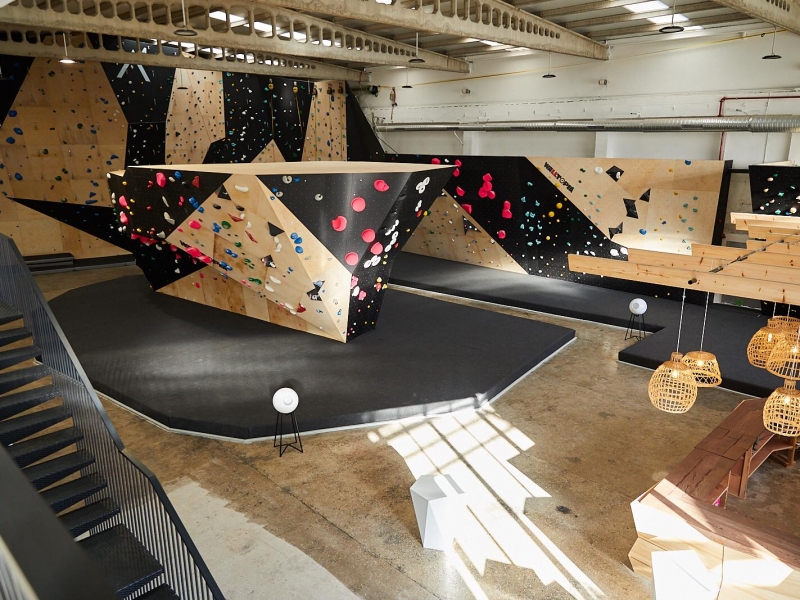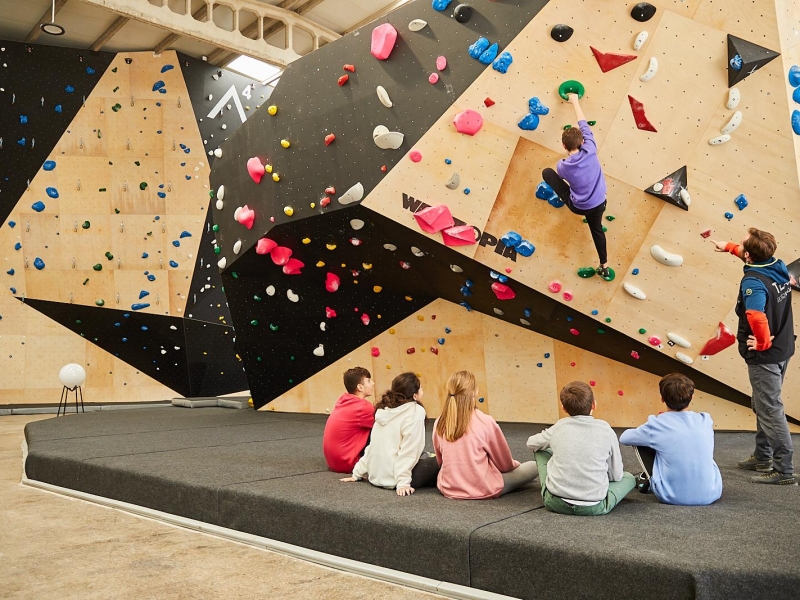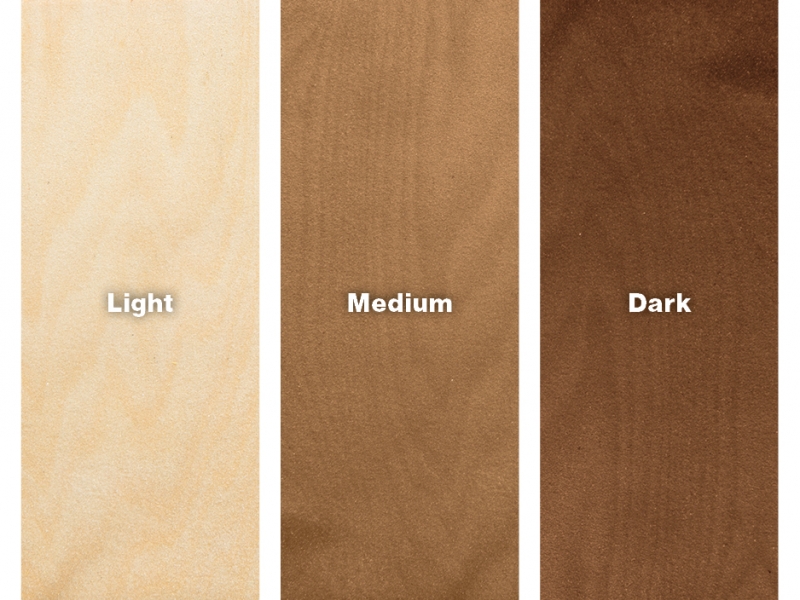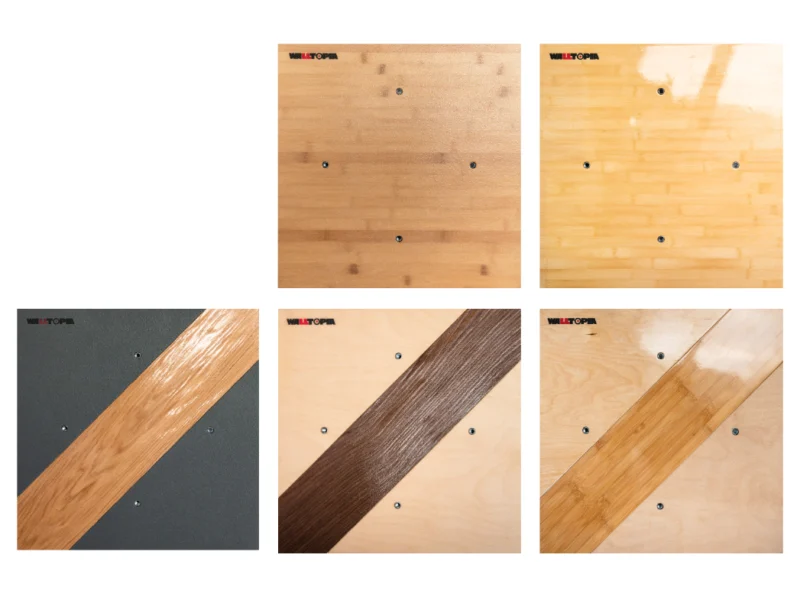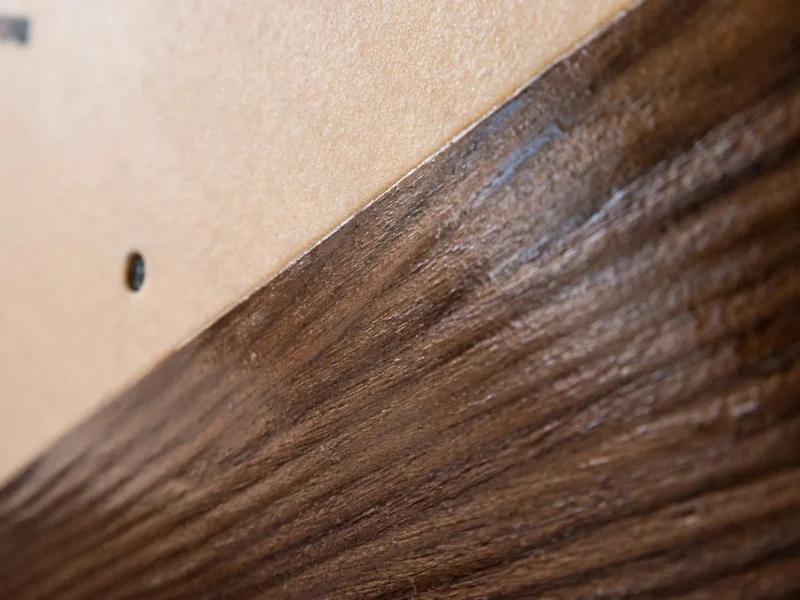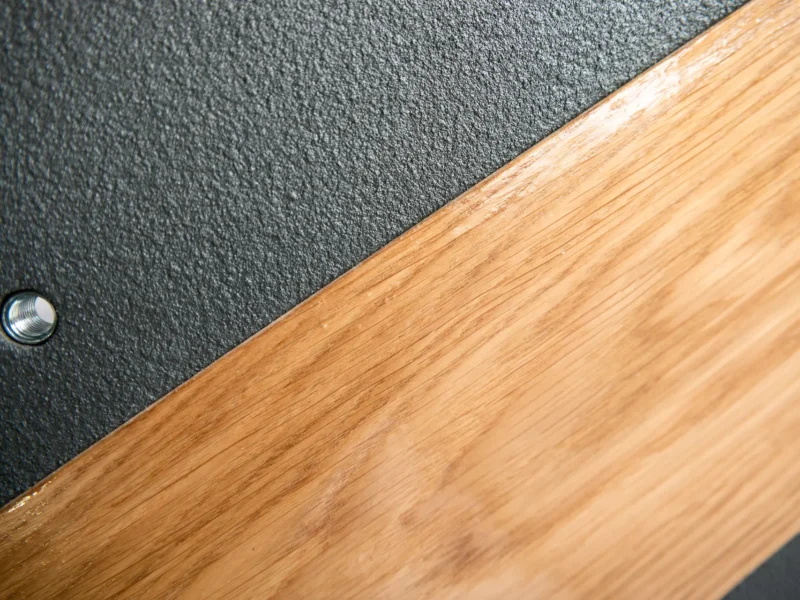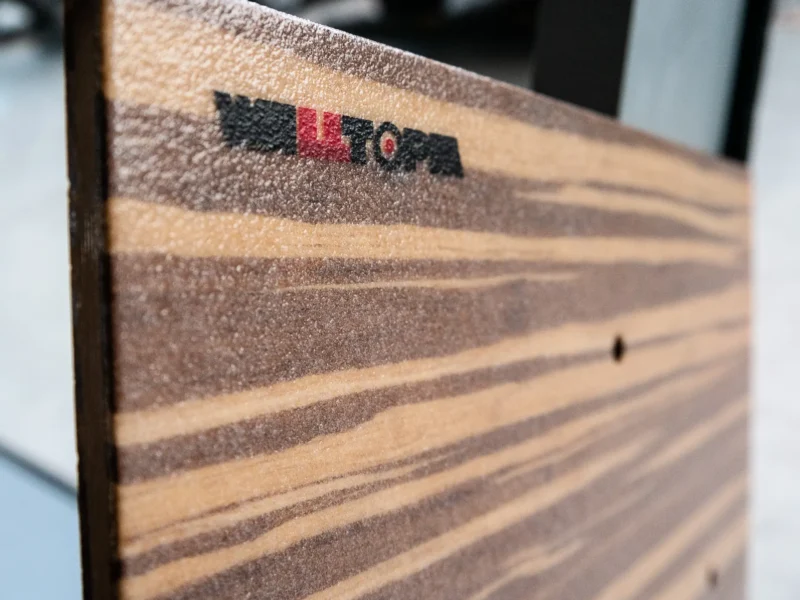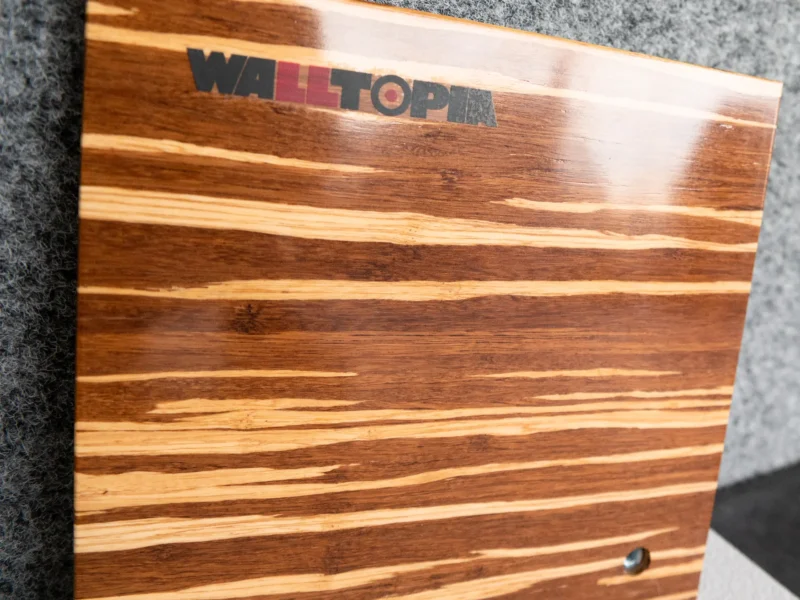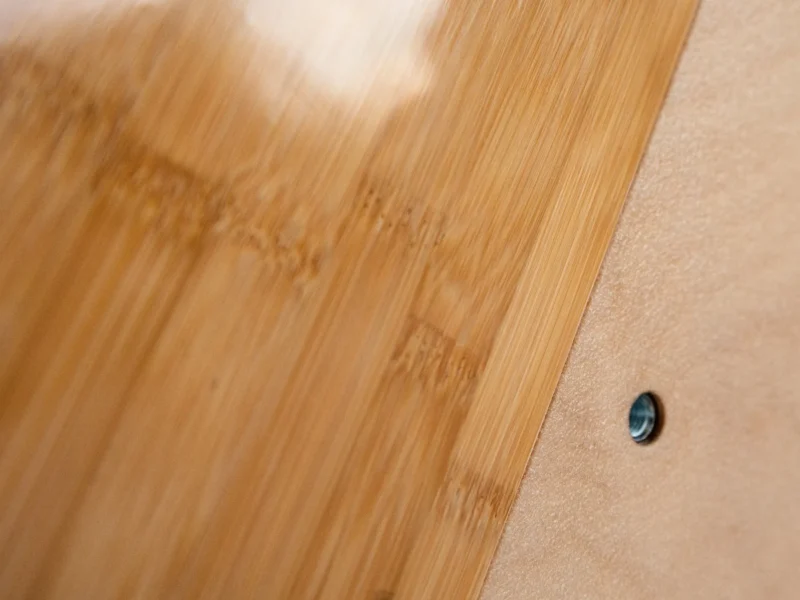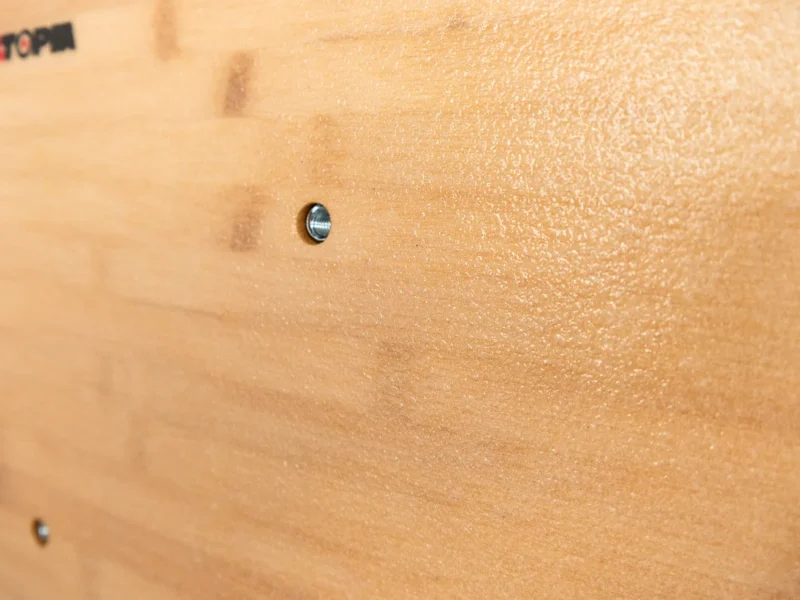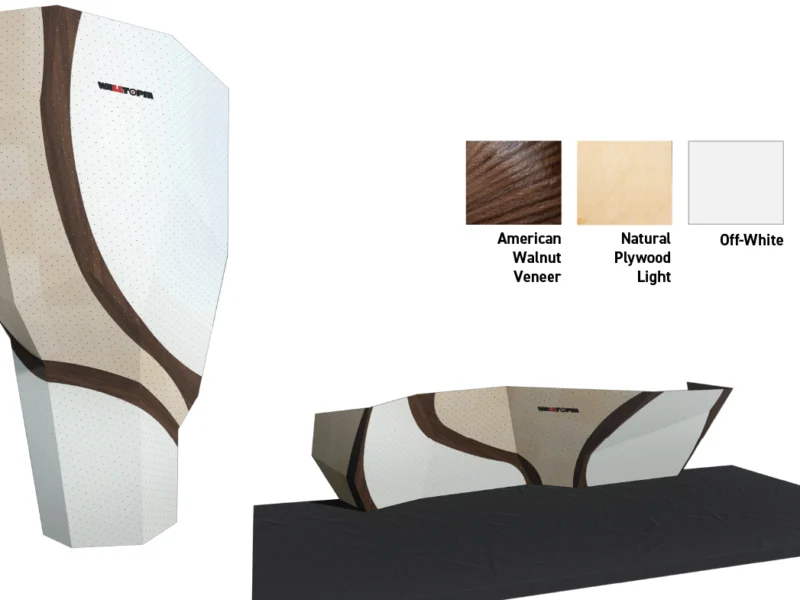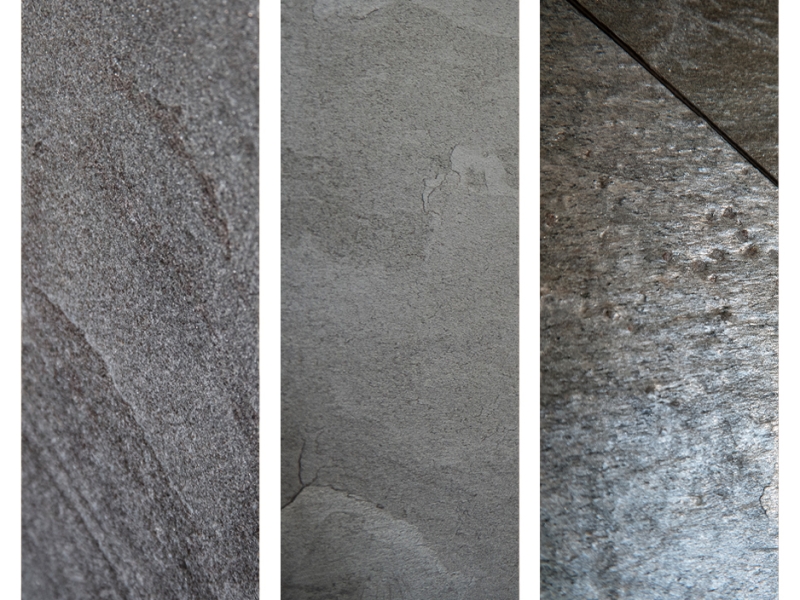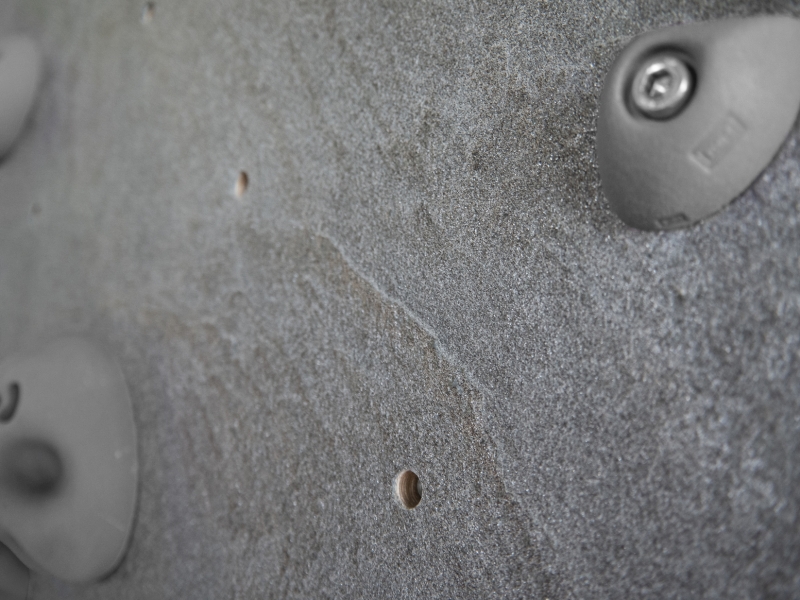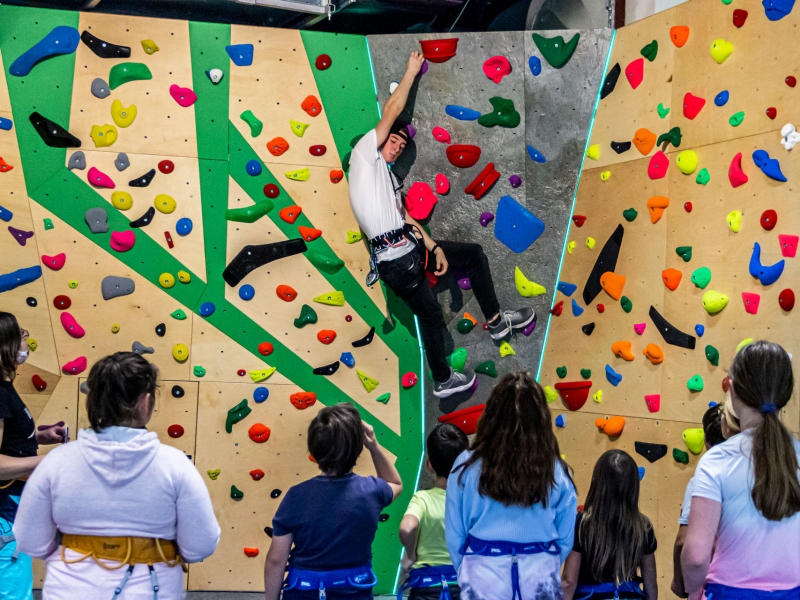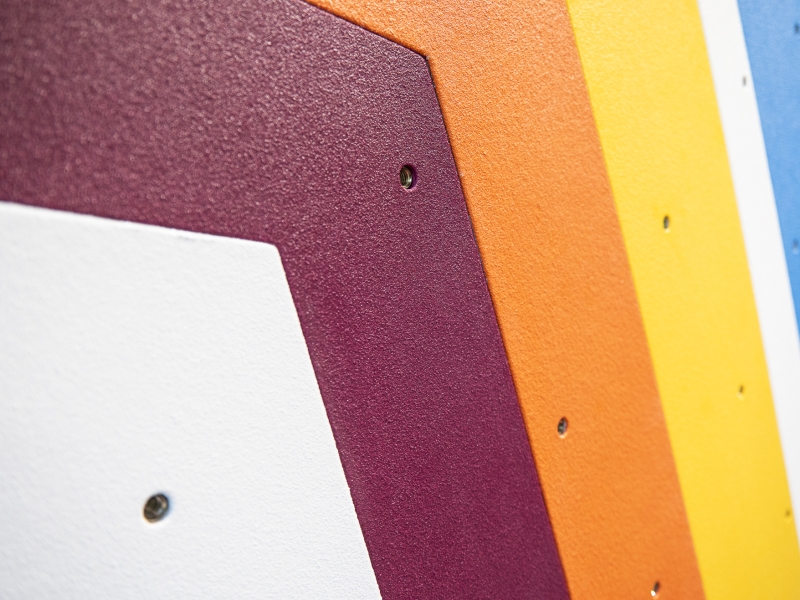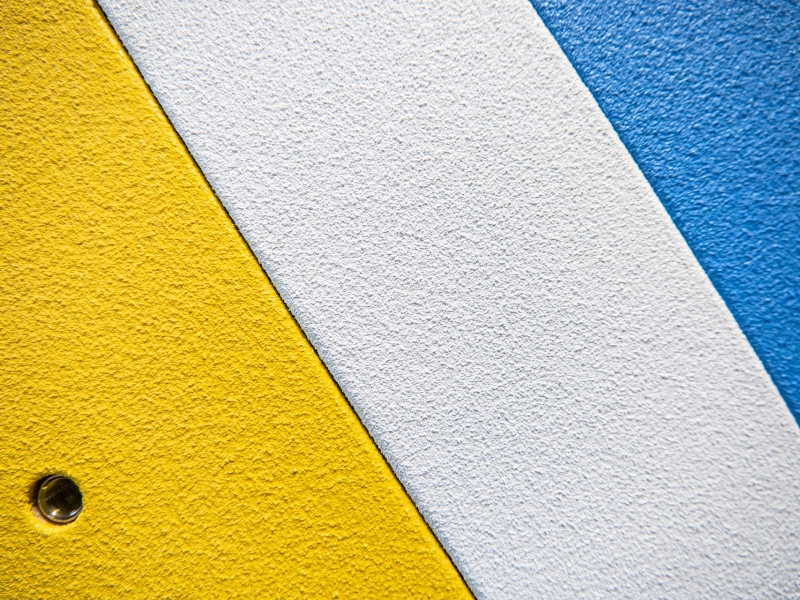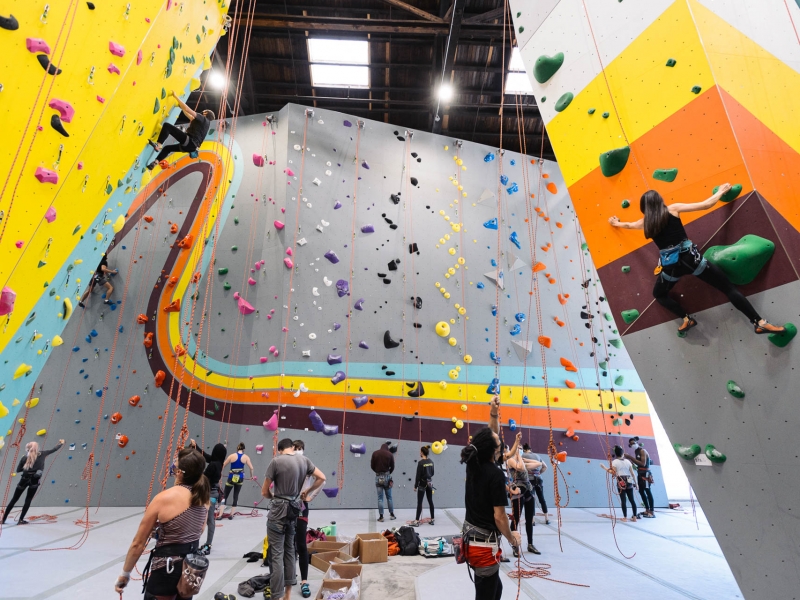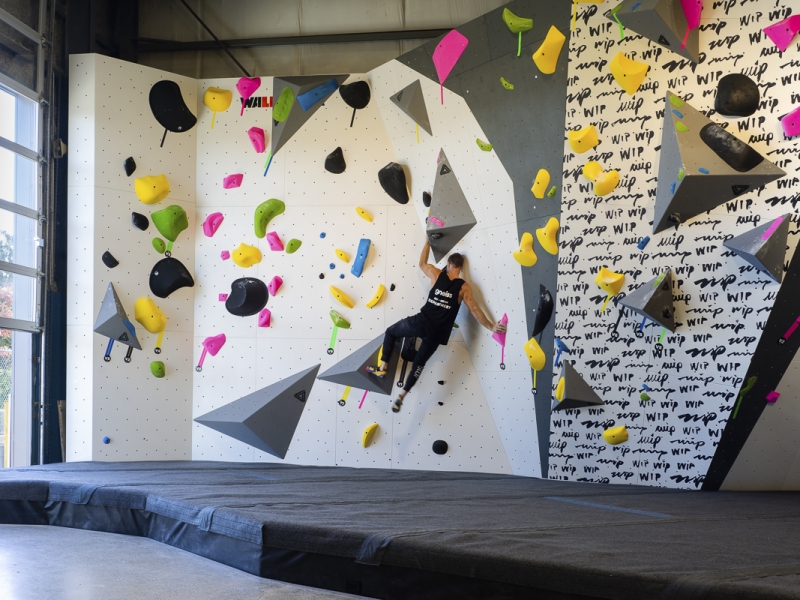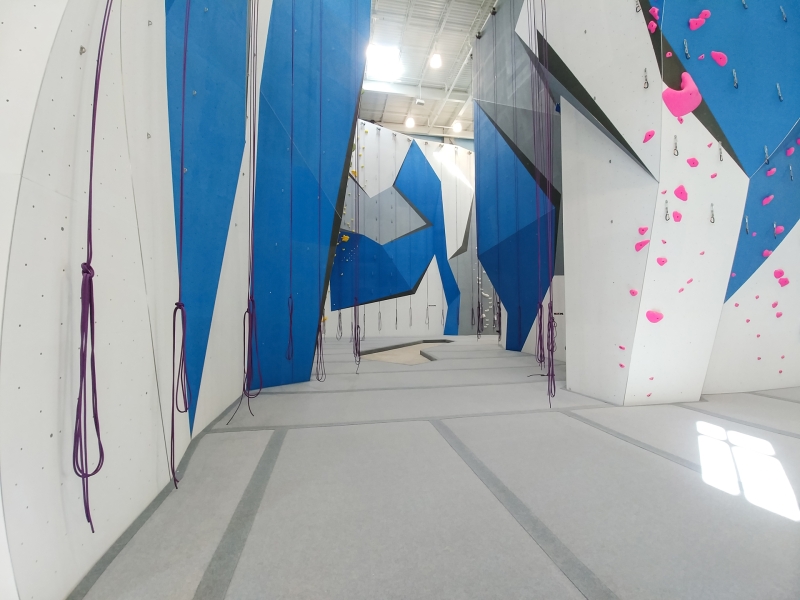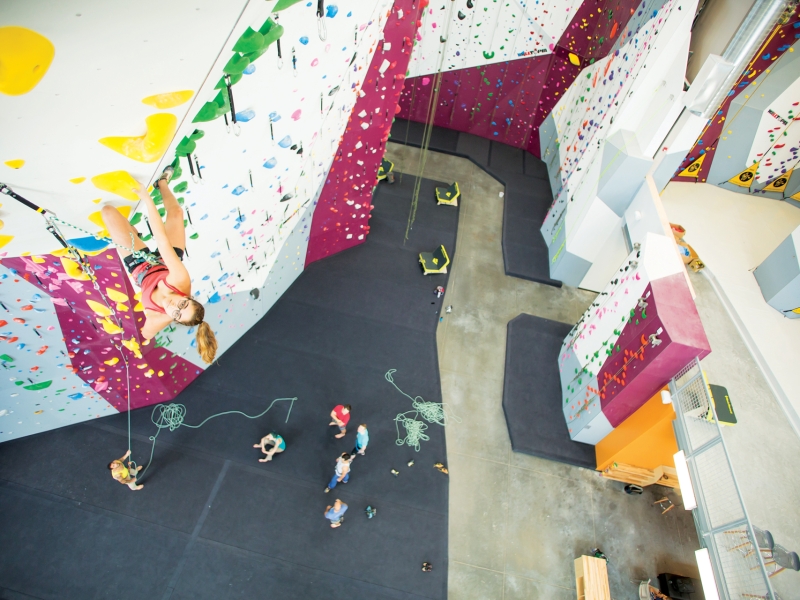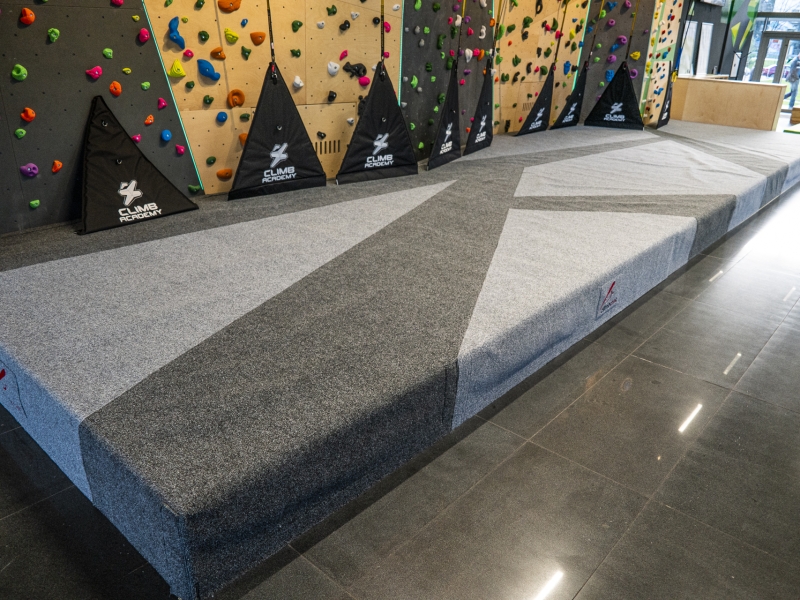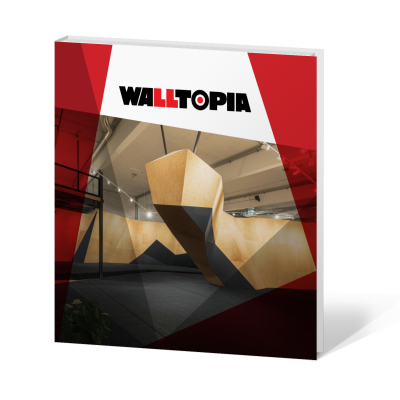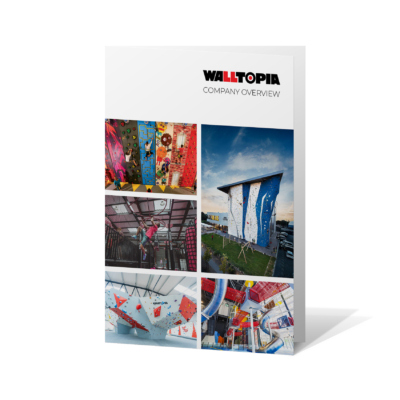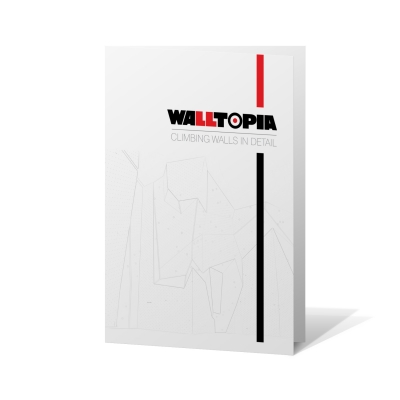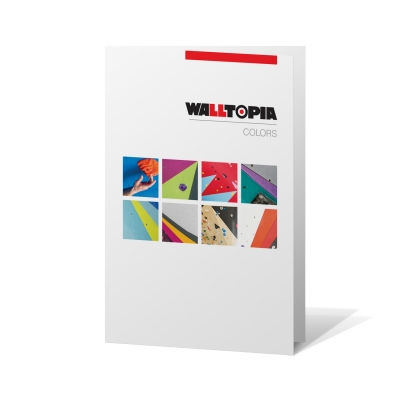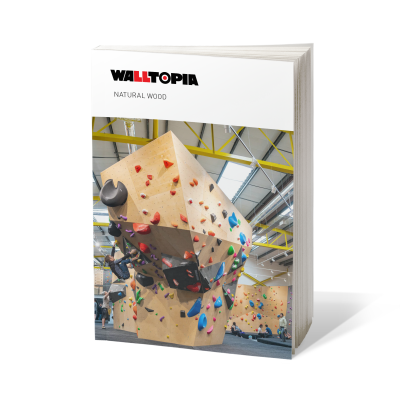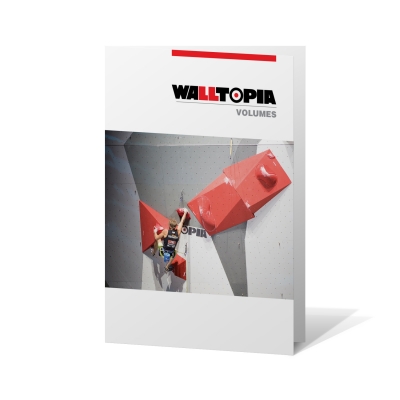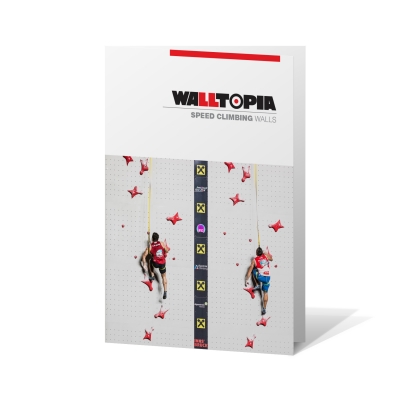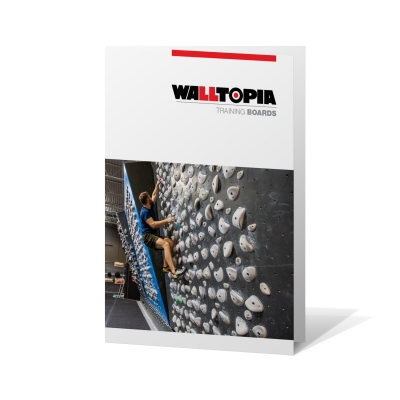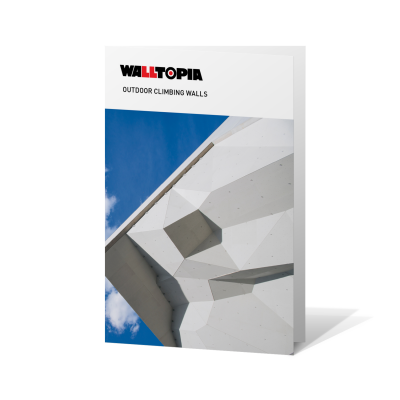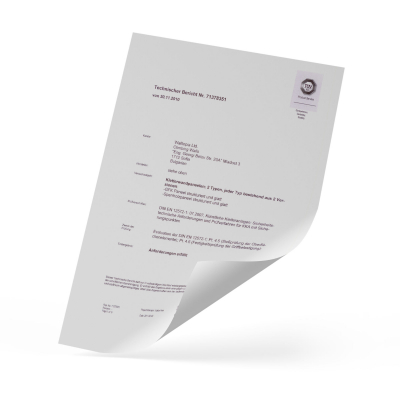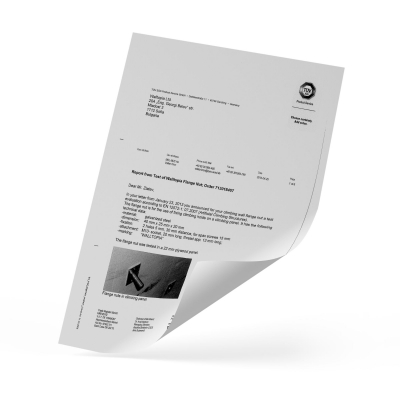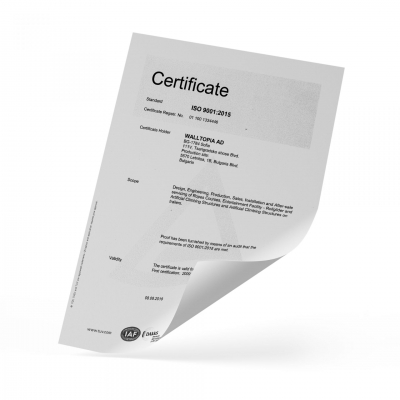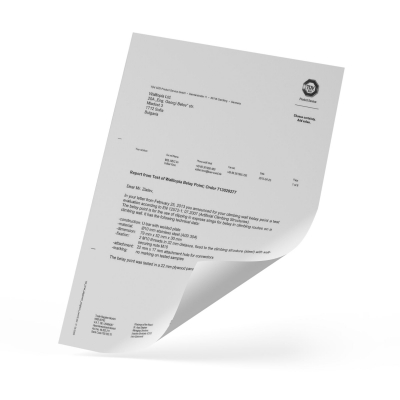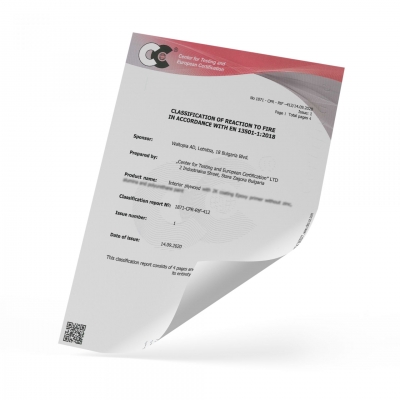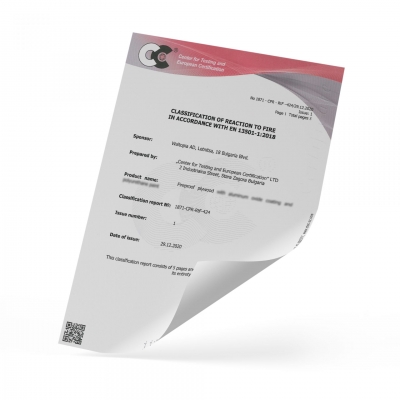About
Walltopia has been designing and manufacturing climbing walls since 1998. Our team of skilled designers and architects creates custom designs, offering an endless variety of shapes, angles, and features. These can be utilized to match the appearance and functionality you imagine for your climbing facility. Our engineers calculate and ensure that the completed project will be safe and precise, adhering to all local and global building codes, legislations, and standards. All climbing walls can be adapted for both indoor and outdoor use.
Building Height Requirements
Min. recommended height: The recommended minimum height for a commercial climbing gym offering rope climbing is 12 m (40 ft) in order to make a sufficient training facility. This requires a minimum ceiling height of 12.5 m (41.5 ft). Shorter walls – about 10 m (33 ft) are acceptable for kids climbing zones and beginner areas. The recommended minum of protection points per lead climbing line are 4 excluding the top anchor.
Max. recommended height: Sky is the limit! The maximum height of a commercial climbing wall is only limited to the height of the building that will house it. The IFSC standard for lead climbing competition walls is 15 m (50 ft). We recommend up to 18 m (60 ft) for optimal operation but we’re ready to take on any “Go big or go home“ challenge.
Lead Climbing
Lead climbing is a discipline in which the climber “leads“ the rope from the bottom to top of the wall, clipping in to fixed protection along the route. It’s a part of the three Olympic disciplines and the goal is to climb as high on the climbing wall as possible within a six minute time restriction. The wall is at least 15 m / 49 ft tall and has at least 7 m / 23 ft overhang. If two competitors reach the same height, the faster wins.
In climbing gyms the lead climbing section is the tallest and most overhanging. It is often placed in the most visible area of the climbing gym as an impressive eyecatcher. A specific thing to keep in mind is that the safety zone of a lead climbing wall goes at least 1.5 m /4.9 ft beyond the projection of the top line of the walls. The lead climbing wall usually hosts competitions and therefore requires spectator area which is often overlooked in the attempt to utilize all available space for climbing.
Top Rope Climbing
Top rope climbing is the easier version of climbing a high wall where the rope is already secured at the top of the climbing wall through a bolted anchor. The falls are far smaller, more similar to a swing than an actual fall and it is suitable for less experienced climbers and belayers as well as for making more “mileage“ of climbing in one training session.
In climbing gyms the top rope climbing area is shorter than the lead climbing section, the walls are less overhanging. It can host more people in a set area and the routes allow to be set more densely. It generally attracts more beginners so it’s advisable to keep the climbing grades at that section in the beginner / intermediate range.
Speed Climbing
Speed climbing is the only climbing discipline that is uniquely focused on competition. It is one of the Olympic disciplines and the main goal is to climb a standardised route on a standardised 15 m / 49 ft wall as fast as possible. Two competitors race head-to-head on two identical side-by-side routes in eliminations principle. The current world record is 5,28 s.
In recent years and especially after its inclusion in the Tokyo 2020 Olympics, speed climbing has gained popularity and many professional and non-professional climbing gyms are adding speed walls to their facilities.
Walltopia is licensed to be IFSC Certified Speed Wall Manufacturer. Walltopia speed walls can be built to meet the IFSC’s official requirements or they can be tailored to fit your specific needs.
Structure
The structure of Walltopia rope climbing walls is made of steel. It can be attached to the building or be self-standing. When attaching to a building the climbing wall structure can be anchored to ferroconcrete structure, ferroconcrete wall or steel structure. Attaching to a wooden load bearing building structure is possible but it is subject to additional engineering costs and individual assessment. If the climbing wall structure is planned as self-standing, it needs to be anchored to the ground and requires significantly more steel and therefore engineering time and costs compared to attachment to a building.
Panel types
The climbing wall panels can be made of plywood or fiberglass, depending on the design style and functionality they have been designed for.
Plywood panels
✓ Made of strong birch plywood
✓ Water resistant coating available
✓ Available in flat or carved surface
Fiberglass panels
✓ Made of fiberglass and polyester resin
✓ Completely waterproof
✓ Durable, yet very lightweight
Panels friction
The perfect amount of friction is the key for the send
The level of friction is always a point of dispute. If you ask ten different climbers to evaluate the same texture, you can be certain that you won’t get the same answer twice. Some of them will say that it was just fine, some will say it was slippery, and others will have found it too rough. In spite of this, we managed to create the surface which will get you the highest customer approval rating. Sleek panels are also an option upon client’s request.
Panels Wear Resistance
This is an incredibly important property of the texture since it’s the part with the highest depreciation rate and defines the facility’s life expectancy. We believe the texture shouldn’t wear off and should also keep its vivid colors for no less than 20 years. In order to control this process, we created a special procedure for the rapid testing of texture fatigue.
Dirt Resistant Coating
To protect the colors of the wall for as long as possible and maintain it clean, we have developed a special dirt-resistant coating that prevents climbing shoes rubber sticking to the surface. However, due to the nature of the materials – soft rubber in contact with hard abrasive surface – and other factors such as overall cleanliness, walls do get dirty over time. Our texture allows for easy cleaning and maintenance of the wall surface.
Maintenance Recommendations
To take full advantage of our dirt-resistant coating, please follow our recommendations:
✓ Use carpet covered flooring
✓ Clean the flooring on daily basis
✓ Do NOT use alcohol-based detergent on the flooring or the walls. Alcohol based detergents can dissolve the rubber on the climbing shoes, make it much stickier and thus lead to dirty walls.
Rope Protection Strips
Ropes are a climbing equipment with high depreciation rate and need to be replaced on regular basis. To prolong their lifespan and keep the neat appearance of the wall at the same time, we have designed the thinnest rope protection strips available on the market.
Benefits
✓ Preserves the aesthetic look of the climbing wall
✓ Extends the life of the rope
✓ Reduces belaying efforts
✓ Protects the protruding angles from rope friction
Features
✓ Elegant metal band (5 mm)
✓ Precise connection on the corners
✓ Installed on all convex corners
T-nuts strength
The only requirement that the standards includes regarding the t-nuts is about their breaking point (according to Annex E). We believe this is not enough. Our t-nut holds are strongly fixed to the wall panel with two solid screws, preventing it from getting out of the panel even if the hold installation fails.
T-nuts distribution
We make sure that there are always enough t-nuts around the corners so that the wall makes no compromise with the route-setting opportunities. Some competitor producers connect the plywood panels via wooden pieces which makes the t-nuts placing on the corners not possible. We have a solution to this and we can place t-nuts close to the edges and corners.
Individual Protection Points
Walltopia U-bolt
Rope climbing walls feature a vital piece of equipment – individual protection points for every lead climbing line. They are connected with the main support structure of the climbing wall. Keeping in mind the load cycles and wear that each point bears in a commercial climbing gym, plus the constant vibrations to which a wall is exposed and sometimes even the lock-nut gets unscrewed resulting in a severe threat to the climber’s well-being, we have invented the U-bolt which is now part of our standard equipment:
✓ It keeps the quick link from wearing out
✓ It is equally strong on both vertical walls and roofs with break value of 35 kN
✓ It’s fixed to the metal construction with not just one but 4 nuts, 3 of which can loosen and the protection point will remain safe.
Protection Points Attachment
Every Corner Matters
We go beyond the requirements of the international standards to ensure all protection points are precisely calculated by creating a complete 3D model with all climbing wall elements. Then we apply the normative loads on each one of the protection points successively and in the process. We find the most unfavorable protection point for each element and each connection between the elements. This way we can calculate the structural integrity of the wall having taken into account every corner of the wall.
Top Anchor
The Walltopia top anchor is a device that is mounted on top of the climbing route, and it is suitable for both top rope and lead climbing. It keeps the carabiners at a distance from the wall plains, therefore removing the risk of friction between the rope and the wall’s texture. This allows the device to be mounted on huge overhangs and roofs along with slabs up to 10 degrees.
Benefits:
- Keeps the carabiners and rope at a distance from the climbing wall
- No friction between rope and the wall’s texture
- Suitable for big overhangs and roofs
- Carabiners and maillons are replaceable – you can easily put any carabiner on the device
- Good for both lead and top rope climbing
- Suitable for slabs up to 10 degrees
- Made of stainless steel (indoor and outdoor use)
Belay bar
The Walltopia belay bar is a device that is mounted on top of the climbing route. It offers a belay station for both top rope and lead climbing, as there are two separate placements for the top rope and the lead rope – a smooth cylinder for the top rope and the regular two facing-locks carabiners for lead climbing.
Benefits:
– Doubles the life of the ropes
-Reduces the effort in the process of belaying
Features:
-Has two carabiners to serve as a top station for lead climbing
-Stainless steel (indoor and outdoor use)
Auto Belay Top Plate
The Walltopia Auto Belay Top Plate is an anchor that is mounted on top of a climbing lane, designed specifically for auto belays. The plate keeps the auto belay at the correct distance from the climbing wall, so that the device does not bounce against the panels and the belay webbing can run freely.
Benefits:
- Specially designed for auto belays
- Dual redundancy according to standards and requirements of auto belay manufacturers
- Possible to use outdoors
Self Belay
The Self Belay is an innovative climbing connector, which increases safety in climbing and adventure centers. The connector cannot be opened accidentally or on purpose during climbing – users can connect to and disconnect from the device only when they are on the ground. The Self Belay also helps operations by reducing the number of required staff members. Participants as young as 5 years of age can use the device on their own.
TRUEBLUE
The auto belay devices automatically retract the rope during ascent and control the speed during descent or in the case of a fall. Climbing walls can operate with different kinds of auto belay devices but we have chosen to partner with the top manufacturers one of which is Headrush, the producer of TRUBLUE Auto Belay. With its high quality design, patented magnetic technology, and reliable performance the TRUBLUE Auto Belay has performed over 2 billion descents in over 60 countries on 6 continents. Annual maintenance is required for each device.
Perfect Descent
The auto belay devices automatically retract the rope during ascent and control the speed during descent or in the case of a fall. Climbing walls can operate with different kinds of auto belay devices but we have chosen to partner with the top manufacturers one of which is Perfect Descent. Perfect Descent uses mechanical centrifugal brake technology and is double redundant, lightweight and compact. Annual maintenance is required for each device.
Autobelay Gates
The auto belay gates are the attachment point of the device when not in use. They are designed to prevent climbers from attempting to climb unattached and to be the last point of warning and checkpoint whether the belay device has been attached to the user’s harness. They also serve the purpose of informing a passer-by when the auto belay is being in use and to discourage them from walking underneath.
Custom colors and prints are available upon request. Bright colors are recommended in order to easily catch the climber’s attention.
Design Styles
Geome3x
Walltopia's most popular style
- Polygonal multiangled planes provide an endless variety of three dimensional design possibilities with clean and minimalistic appearance.
- Limitless range of color combinations give every climbing wall a unique and distinctive look.
- Flat surface panels allow for a great t-nut density and plenty of route setting options.
- Geome3x can be manufactured for both indoor and outdoor use.
- The panels can be carved to achieve micro relief.
- Geome3x is the most economically efficient solution, providing everything a gym needs at a reasonable cost.
3D Curves
Perfect for signature features
Inspired by the famous sandstone canyons of Utah and the boulders of Fontainebleau, 3D curves fills the gap between architects’ imagination and the technical restrictions of plywood panels.
- Often used in combination with plywood walls to create a signature feature in the climbing gym.
- Made of fiberglass: absolutely no restriction in terms of shape.
- Appropriate for both indoor and outdoor use. Highly durable.
- Without micro relief, high T-nut density can be achieved and route setters can make the best use of the space available.
Although aesthetically pleasing, curved forms pose restrictions on routesetting as they are not suitable for big holds and volumes and that should be taken into consideration when creating 3D curves features.
Rocktopia
Rocktopia is our way of going back to the roots of rock climbing. These are walls that resemble real rocks. To ensure the natural feel, the molds that shape the fiberglass panels have been casted from real rocks at our home iconic crags.
Rocktopia provides a great variety of rock features with various relief that can present a challenge to both beginners and advanced climbers. The surface can be high or low relief depending on the desired level of difficulty. The neat placement of the holds is achieved by our flat underhold technology that minimizes the risk of hold breakage. Although there are no restrictions in the color options, we recommend the realistic rock look – the different hues of
limestone, granite or sandstone.
Besides climbing walls, the Rocktopia features can be used to create artificial rocks and boulders for urban outdoor environments such as parks, recreational areas and zoos.
Rocktopia rock types:
• Limestone
• Sandstone
• Granite
Additional Features
LED Add-ons
Enhance your wall with built-in LED illumination. Elaborate the design of your gym with custom shapes that can glow in any color using RGB LEDs. The features currently offered are LED cracks, LED strips and LED band and can be incorporated in any climbing wall design style.
Plexiglass Features
Make a section of your climbing wall transparent with a piece of plexiglass that is actually climbable. Be it a window letting daylight in through a facade climbing wall or simply a design feature, small sections of plexiglass can be incorporated with the plywood or fiberglass panels. To keep it transparent, texture cannot be added, so keep in mind that the friction would be restricted in that section.
Standard Colors
One of the most important details of a climbing wall is its color scheme, as it affects the entire atmosphere of the gym. Walltopia uses a standard palette of 16 colors, which allows for numerous color combinations, clever compositions and creative interior designs.
Natural Wood
The natural wood panels look really well in combo with solid color panels while providing a cozy atmosphere and exactly the same amount of friction as all Walltopia walls. The rubber resistant coating will make it easy for the operators to maintain a good looking wall over time. Walltopia natural wood comes in three shades: light, medium and dark
Natural Wood Veneers
Natural wood veneers add another dimension to the climbing wall design. Our designers work with a large selection of veneers, ask your contact person for the current availabilities and pricing. A popular approach is the combination of a light natural plywood with dark American wallnut veneer.
Natural Rock
The natural rock panels are a great signature element in the design of a climbing gym. They look attractively in combo with solid color or natural wood panels while providing a cozy earthy atmosphere. Extracted from real rock, the climbing wall panels with stone veneer not only look but also feel like natural stone because they are…well, natural stone. Walltopia natural rock comes in a variety of textures and shades, ask your representative for the current availabilities.
Custom Paint & Split Color
Want more colours on your wall?
Think of any combination and we can make it happen. With Walltopia’s custom paint you can have a number of different colours outside our standard range. Our Custom Color Split technology allows for creative forms in the climbing gym design no matter the complexity of the shapes on every single panel. Our technology allows for unlimited design opportunities, perfect consistency on every single panel and superb execution.
Rope Wall Mats
The standard rope wall mats have good stiffness for walking and are appropriate for falls from up to 3 m (10 ft). They consist of either a thick layer of heavy open cell polyurethane foam, or a closed cell carpet bonded foam combined with the open cell foam.
One More Life Safety Mats
One More Life safety flooring is an innovative flooring solution by Climbmat that could prevent severe injuries in the event of a fall from heights up to 16.5m / 54 ft. It is the first type of flooring that has undergone tests for safer falling from heights using precise human analog. Although there is no mandatory flooring regulation for climbing-based activities over 5 m, we feel it as our moral obligation to stress on the importance of adding proper matting for climbing walls and climbing-based attractions especially if they target children.
Catalogs & Brochures
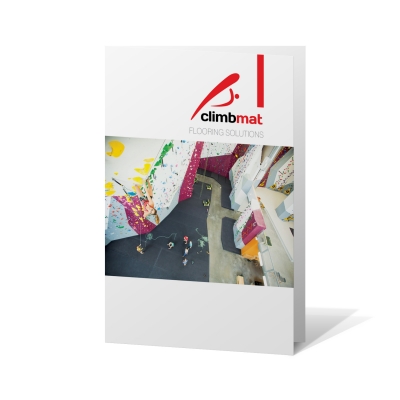

Climbmat Flooring Solutions
Certificates
